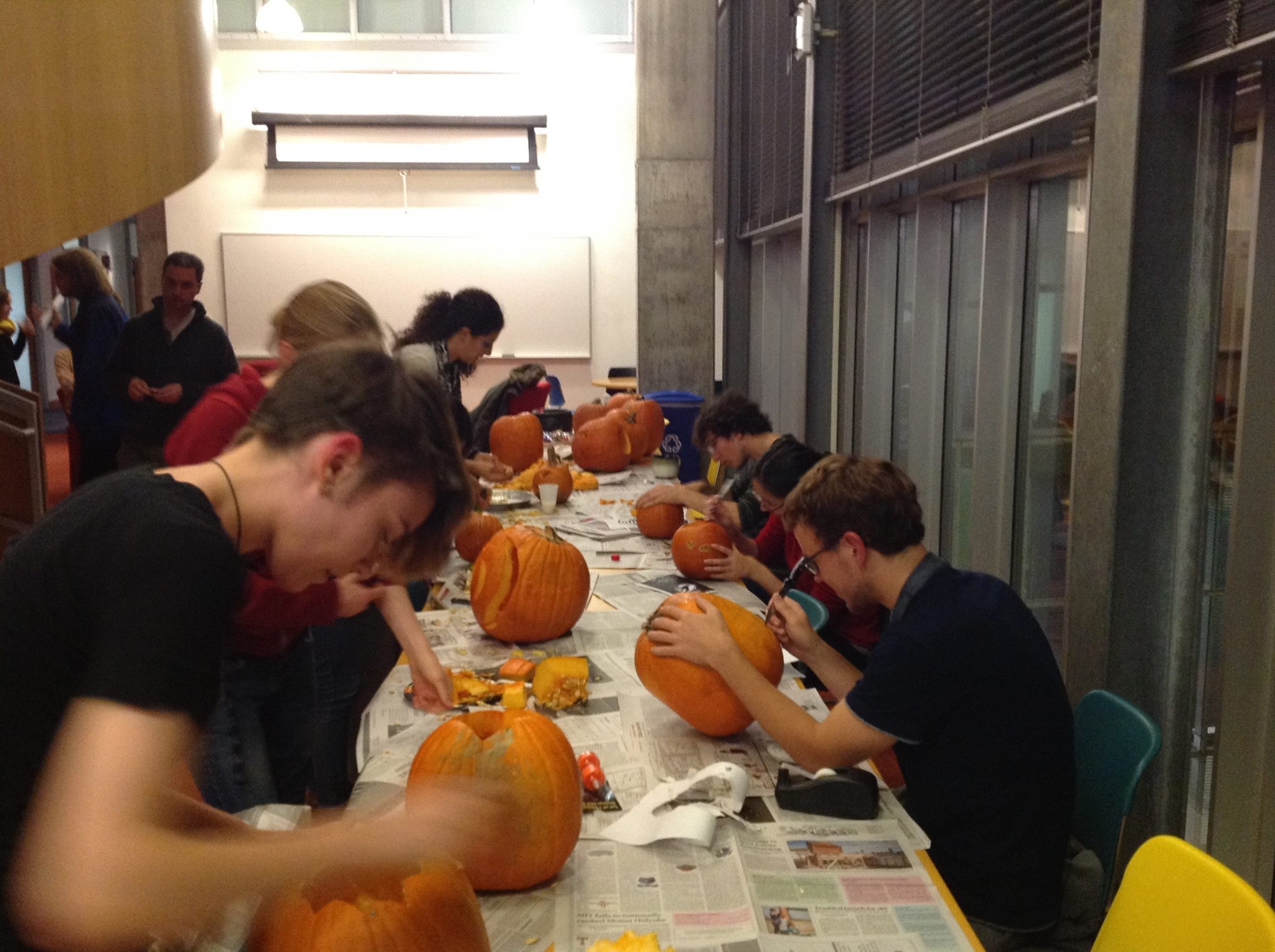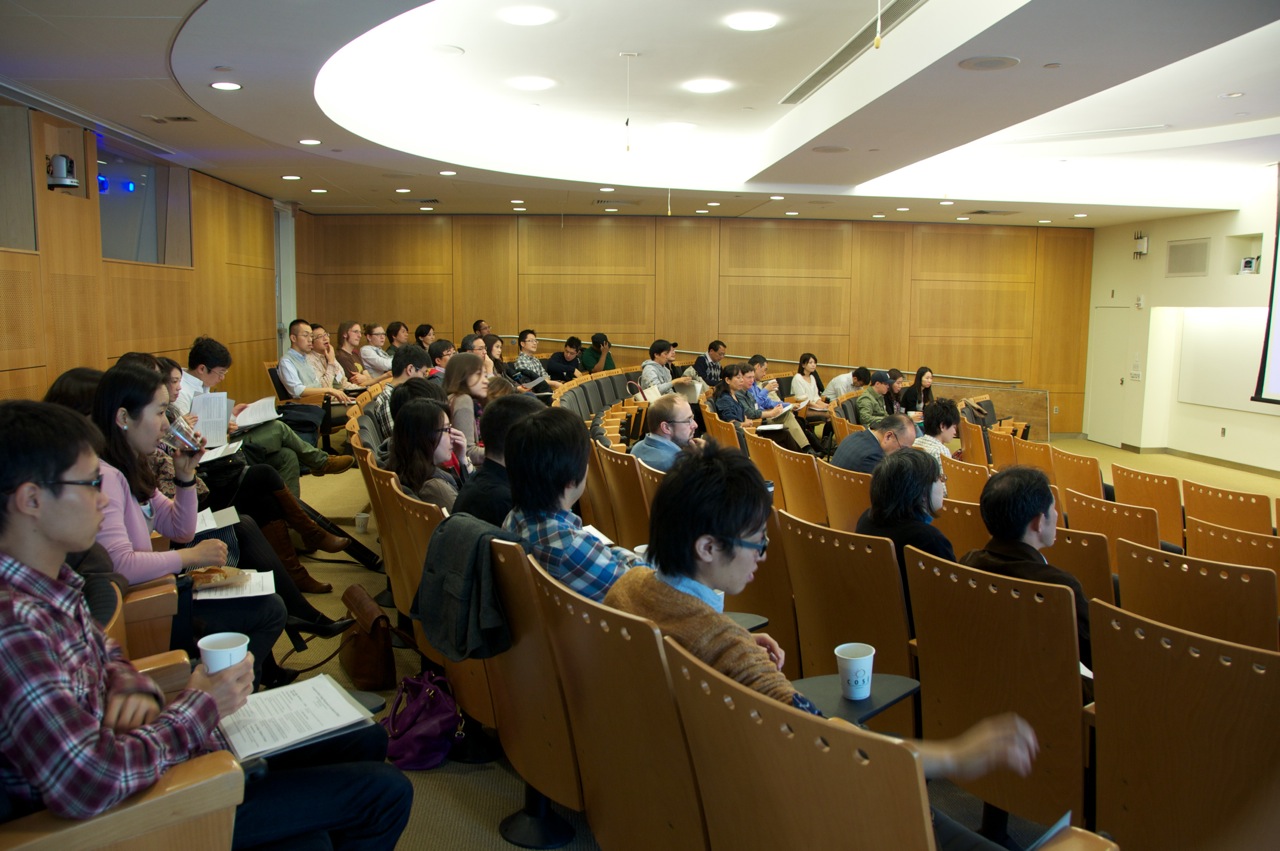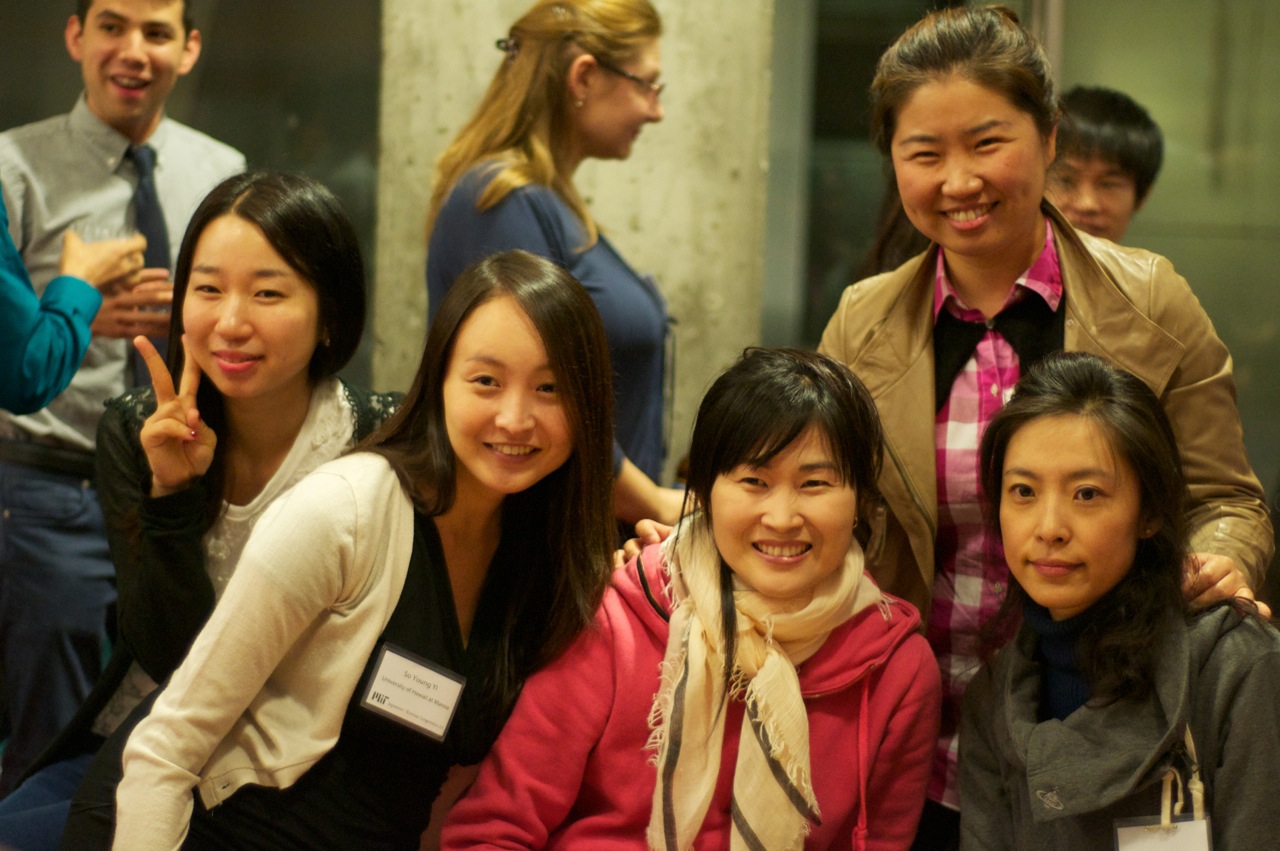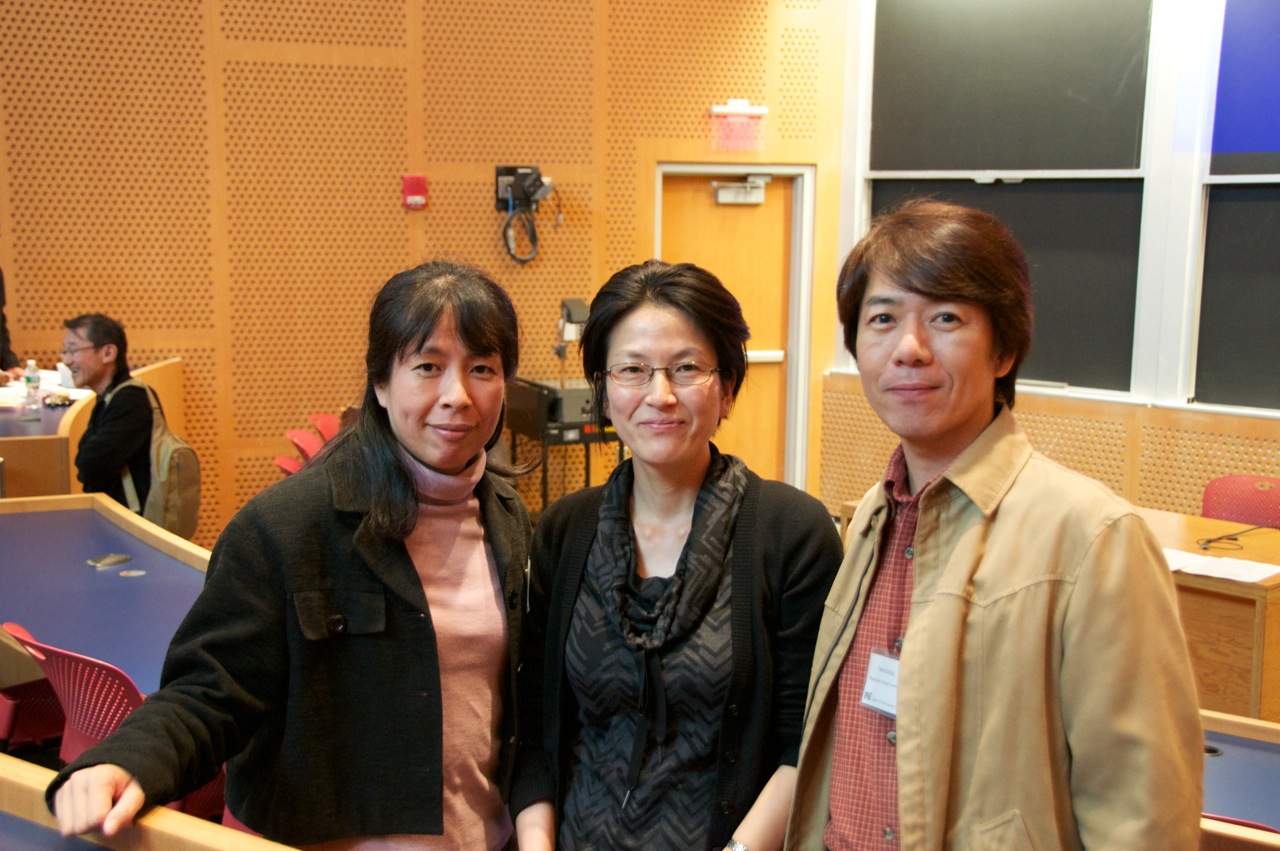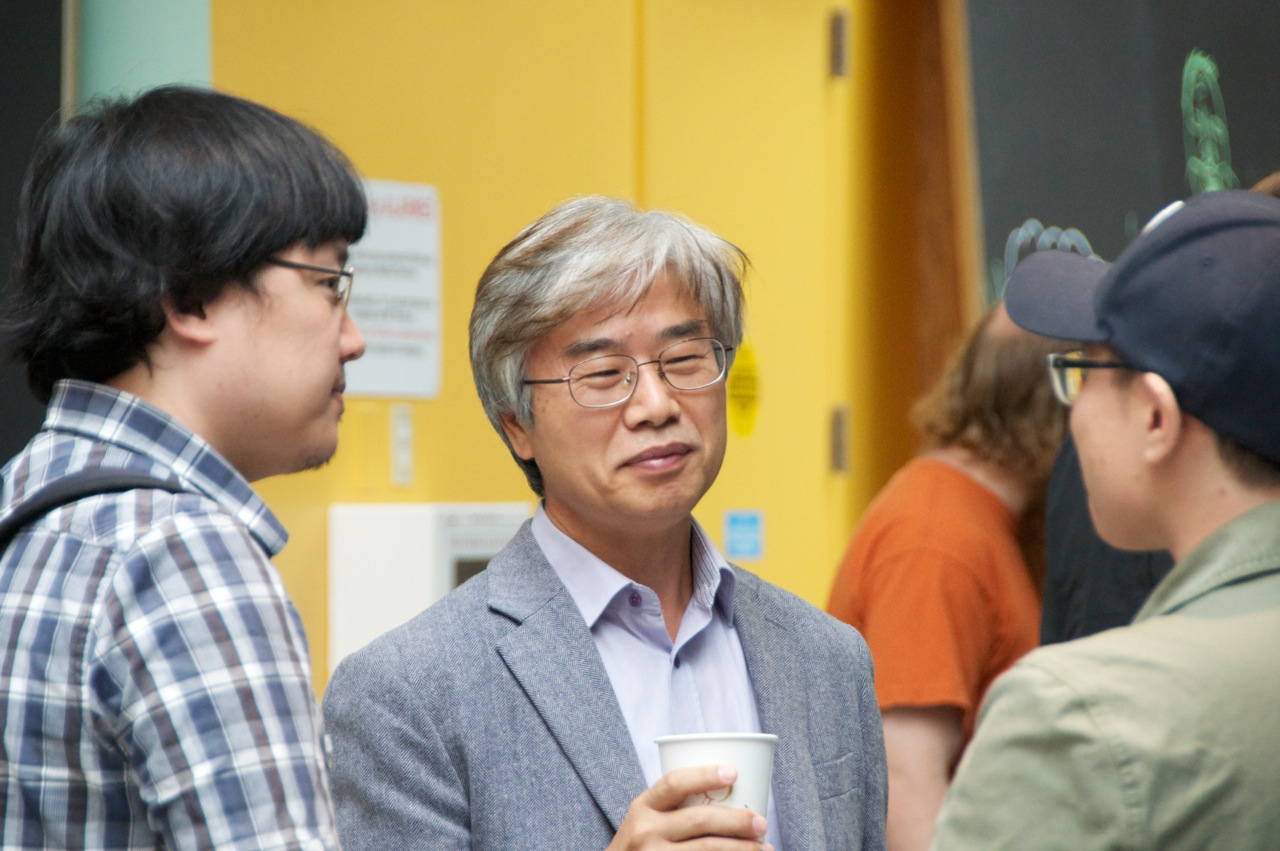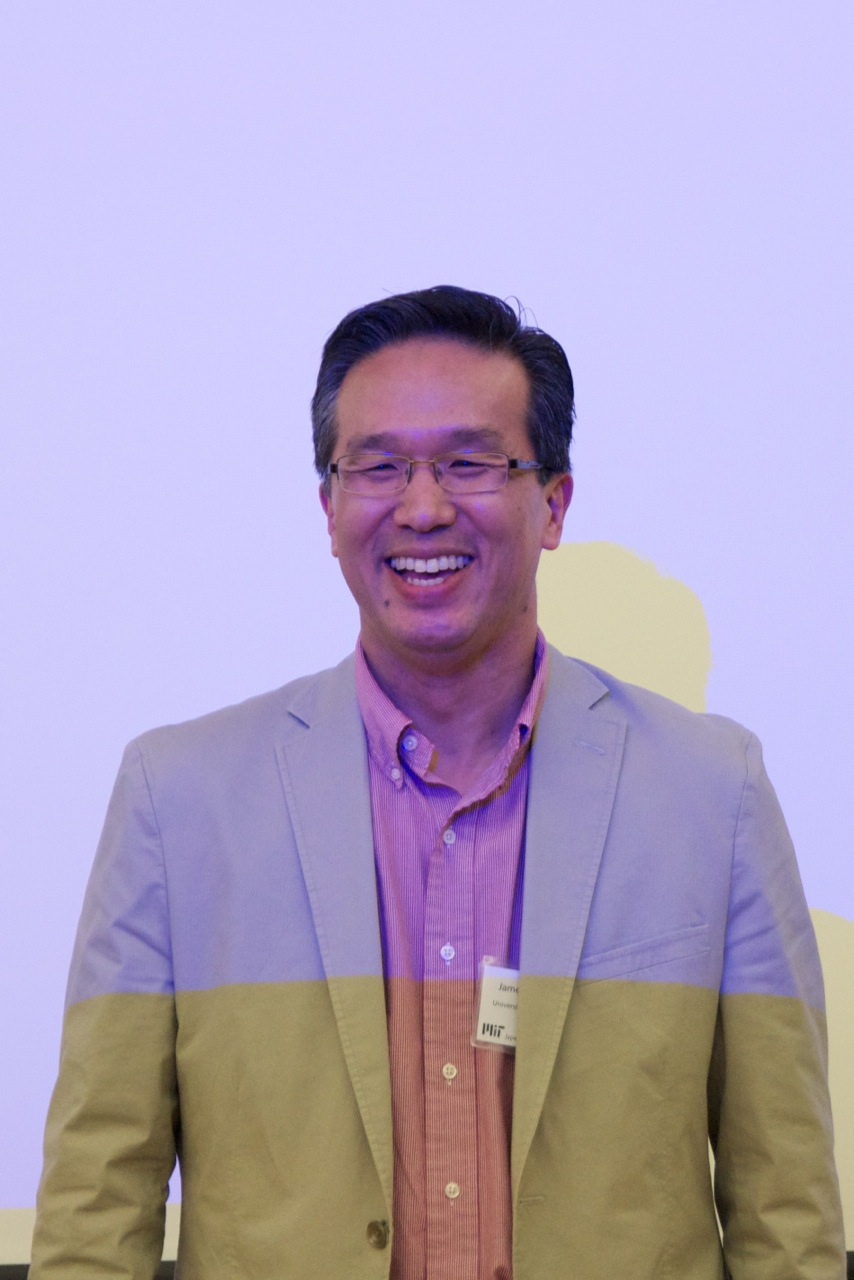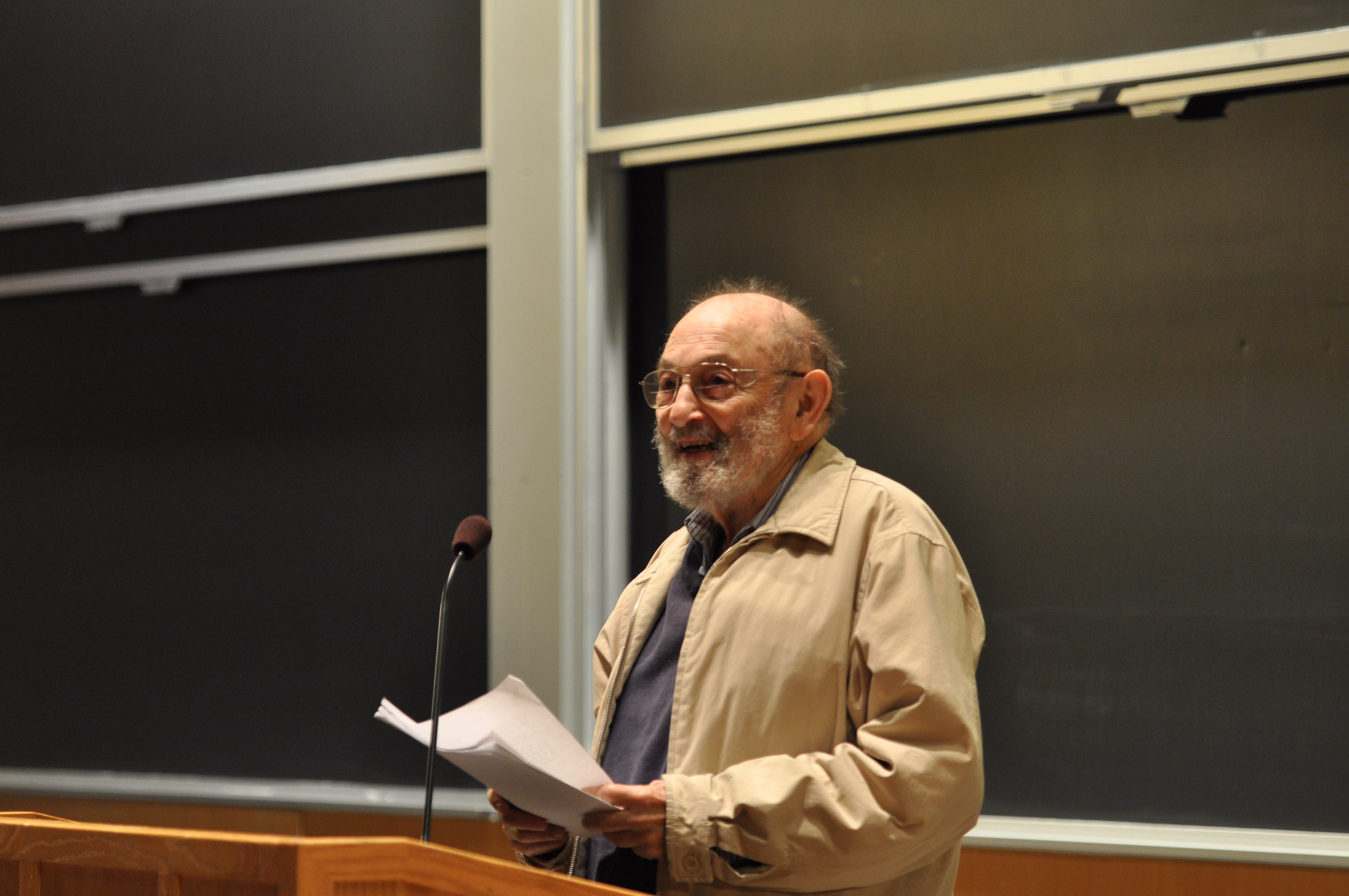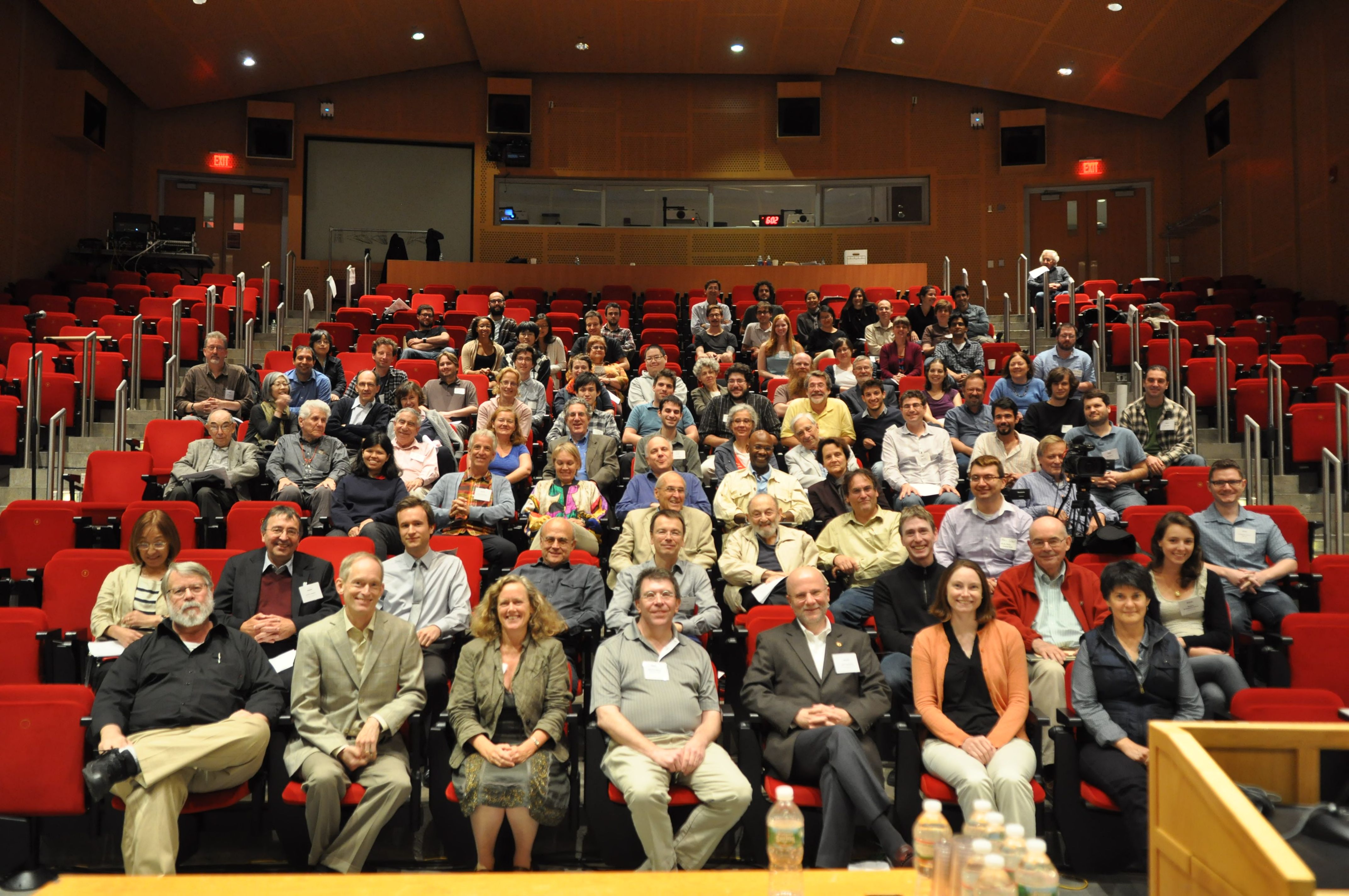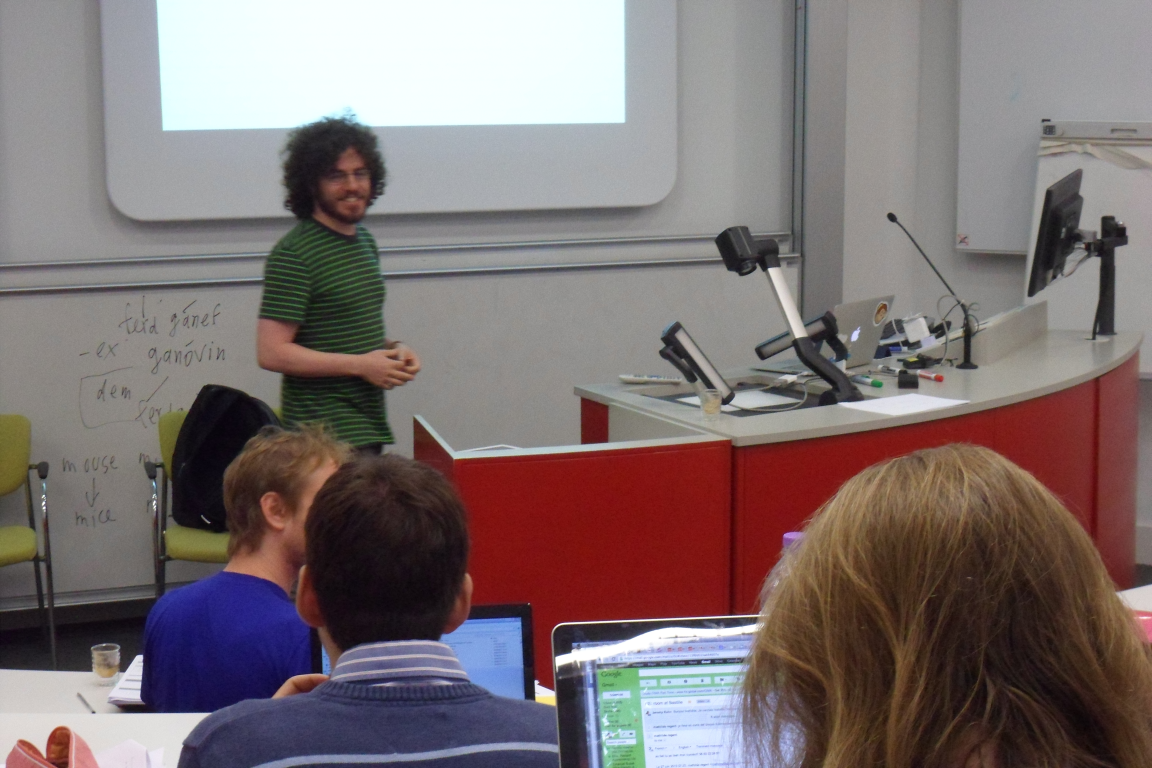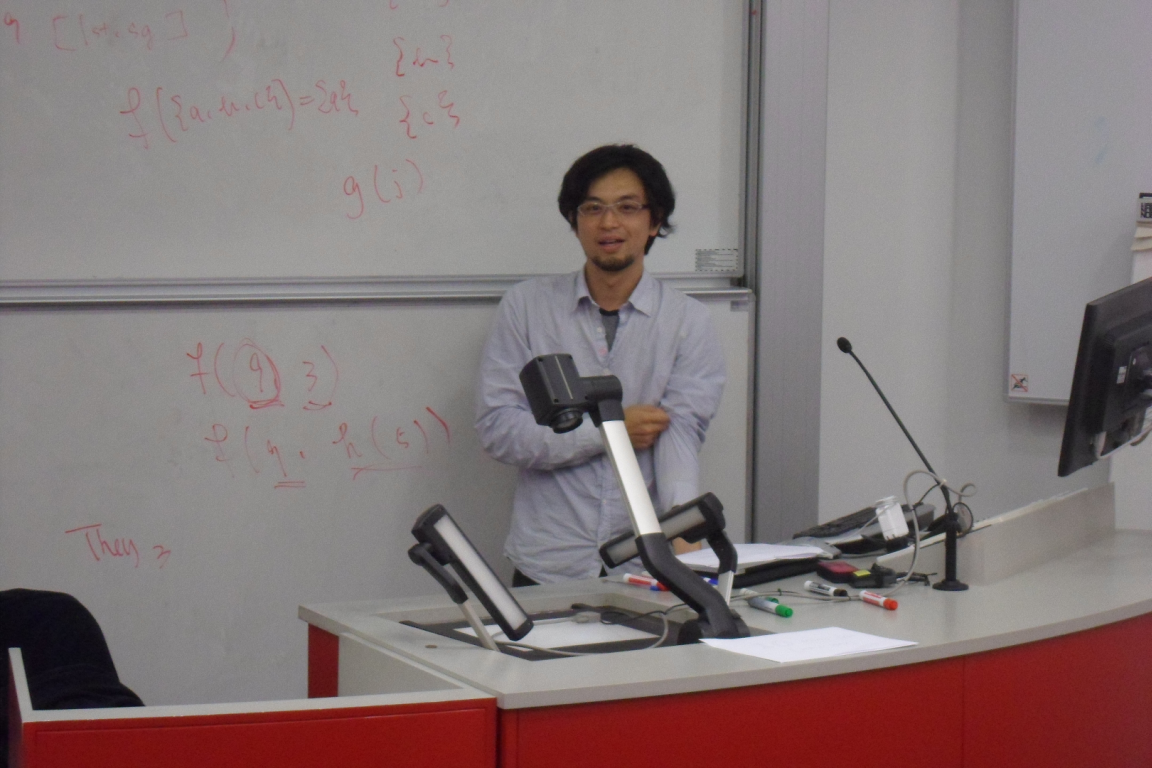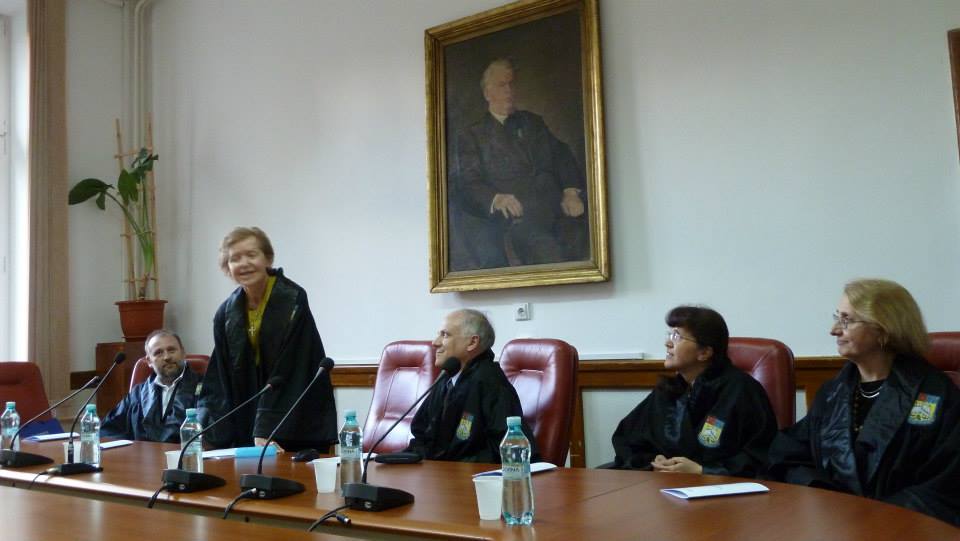With Fall semester classes ending this week, we will go on our regular Winter semi-hiatus until classes resume at the beginning of February. As always, we will report exciting breaking news as it happens (that’s why it’s just a semi-hiatus), but otherwise — see you in 2014!
Search Results
Phonology Circle II 12/13 - Sandrien van Ommen
Speaker: Sandrien van Ommen (Utrecht Institute of Linguistics, OTS) (joint study with Rene Kager)
Date/Time: Friday, Dec 13, 3 pm (please note unusual time)
Location: 32-D831
Title: Language-specific metrical segmentation in Dutch, Turkish, Polish and Hungarian
With the current study we investigated the role of stress as a boundary marker in processing. Previous studies have shown that listeners interpret stressed or strong syllables as potential word-beginnings in a.o. English (Cutler & Norris, 1988), and Dutch (Quené & Koster, 1998; Vroomen & de Gelder, 1995). This is interpreted as evidence for the Metrical Segmentation Hypothesis, which predicts that listeners have and use a parsing ability based on edge-aligned stress. Unfortunately, most empirical evidence supporting this hypothesis comes from languages with (statistically dominant) word-initial stress. Evidence for a facilitatory effect of right-edge aligned stress is sparse and inconclusive (see a.o. Toro-Soto et al., 2007, Cunillera et al. 2008, Kabak et al., 2010). We designed a cross-linguistic experiment to address the question of language-specificity in metrical segmentation. In this experiment, we measured response latencies in a non-word spotting task with six different metrical conditions. The participants were speakers of Dutch (penultimate word-stress, variable), Polish (penultimate word-stress, fixed), Turkish (word-final stress, variable) and Hungarian (word-initial stress, fixed).
Besides finding the expected overall effect of facilitation of the native canonical stress pattern in (non-)word segmentation, we conclude to have found a language-specific anticipitory use of stress in segmentation. Furthermore, the results invite us to further investigate the role of peripherality and variability of stress in processing. To gain more insight into what role these factors may have, we recently started designing a computational model for the acquisition and use of metrical patterns. This is a very recent and tentative project that we welcome discussion on.
Syntax Square 12/3 - Yusuke Imanishi
Speaker: Yusuke Imanishi
Title: Default ergative: A story of Ixil
Date/Time: Tuesday, Dec 3, 1-2p
Location: 32-D461
I will discuss the unexpected emergence of the ergative in intransitive clauses of Ixil (Mayan). This occurs when an instrumental phrase is fronted to a clause-initial position (Ayres 1983, 1991; Yasugi 2012). I will argue that the intransitive subject receives ergative Case as syntactic default Case because it would be otherwise Case-less. It will be shown that a fronted instrumental phrase blocks the assignment of absolutive Case to the intransitive subject. In other words, the unexpected instance of the ergative indicates failure of absolutive Case assignment. To formulate this analysis, I will propose (i) a model of default ergative Case assignment and (ii) the Absolutive Case Parameter in Mayan (cf. Aldridge 2004, 2008; Legate 2008; Coon et al. 2012).
Ling-Lunch 12/5 - Juliet Stanton
Speaker: Juliet Stanton
Title: Constraints on English preposition stranding
Date/Time: Thursday, Dec 5, 12:30-1:45p
Location: 32-D461
In this talk, I discuss an asymmetry in English preposition stranding, illustrated by the following contrasts:
(1) Which bench were you sitting on?
Which holiday do you eat lamb on?(2) Not a single bench will I ever sit on.
*Not a single holiday will I ever eat lamb on.I show that the ability of a given preposition (P) to be stranded is partially dependent on whether or not P accepts a pronoun as its complement, i.e. whether or not P is an antipronominal context (Postal 1998). Certain A-bar extractions permit stranding of antipronominal Ps, while others do not.
I extend the theory of wholesale late merger (Takahashi 2006, Takahashi & Hulsey 2009) and propose that while a subset of A-bar extractions obligatorily leave full copies in the base position, others don’t. I show that this proposal derives the observed restrictions on P-stranding, and present some additional evidence in support of the analysis.
AAAS congratulations for Wayne & Joseph
Congratulations to Joseph Aoun (MIT Linguistics PhD 1982, President of Northeastern University) and to Professor of Linguistics Emeritus Wayne O’Neil on their election as Fellows of the American Association for the Advancement of Science!
Colloquium 12/6 - Gillian Ramchand
Speaker: Gillian Ramchand (University of Tromsø/CASTL)
Time: Friday December 6th, 3:30-5pm
Venue: 32-141
Title: Minimalism and Cartography (joint work with Peter Svenonius)
Abstract:
While many current syntacticians have felt queasy about embracing the full extent and number of the functional decompositions as proposed in classic cartography (e.g. Cinque 1999), we believe that cartography in the broad sense is essential for any generative theory - it consists in establishing what the category labels of the symbolic system are, how they are hierarchically organized, and how rigidly. We too find it implausible that extremely fine-grained functional sequences of highly abstract heads with no deterministic relationship to compositional semantics is either universal or innate. However, we do think that the parts of the functional sequence that are universal and driven by innate mechanisms are directly related to pressure from the interfaces, and in particular to the facts about human concept formation. So we will push a strong semantically grounded thesis about why templatic effects of a certain sort emerge. It is an empirical question how fine-grained the universal spine is (cf. also Wiltschko, to appear), although we suspect with Wiltschko that it is rather abstract. In this talk I will first outline the basis for a methodological reconciliation between the practice and results of cartography, and more minimalistic pressures to explain and ground the complex ordering effects we see on the surface. Secondly, I will exemplify with a case study. Using the domain of English auxiliary orders, I argue that one cannot ignore the detailed mapping evidence, and that understanding it is crucial to making progress on the more theoretical questions of universality vs. language particularity, locality effects/phases, and the mapping to the cognitive-intentional systems of mind/brain.
In this talk therefore, I will offer entertainment both for those who like to talk about the ‘big picture’ and and for those who like to get their hands dirty: (i) an articulation of distinctive kind of research programme which many are actually embarked on but which needs a name and some more visibility, (ii) a novel compositional semantic take on aspectual auxiliaries and the modal circumstantial/epistemic distinction and (iii) a new perspective on ‘affix’-hopping.
Phonology Circle 11/25 - Juliet Stanton
Speaker: Juliet Stanton
Title: Factorial typology and accentual faithfulness
Date/Time: Monday, Nov 25, 5:30p
Location: 32-D831
I investigate the nature of accentual faithfulness constraints and their rankings relative to markedness constraints, starting from an analysis of stress in 23 Pama-Nyungan (PN) and neighboring Australian aboriginal languages (e.g. Pintupi, Diyari, Warlpiri). In many of these systems, unsuffixed forms are stressed identically, but suffixed forms differ according to the type of paradigmatic uniformity effect observed. The proposed account differs from prior work (e.g. Crowhurst 1994, Kager 1997, Kenstowicz 1998) as it does not appeal to feet and uses directional base-derivative (BD) identity constraints (Benua 1997) to model cyclic effects.
Predictions of the constraint set are explored through a factorial typology. To constrain the typology’s predictions, I introduce the visibility hypothesis: constraints backed by positive evidence from frequent forms dominate constraints that lack such evidence. Integrating the visibility hypothesis into the factorial typology results in accurately restrictive predictions for the typology of stress-morphology interactions.
A Brief Whamit! Issue
We have a shortened Whamit! due in part to Thursday and Friday being holidays. Have a nice Thanksgiving!
Phonology Circle 11/18 - Ryo Masuda
Speaker: Ryo Masuda
Title: The morphophonology of verb doubling in Chechen/Ingush
Date/Time: Monday, Nov 18, 5:30p
Location: 32-D831
As described by Conathan & Good (2001) and Nichols (2011), Chechen and Ingush (Northeast Caucasian) exhibit a case of word-level reduplication, henceforth verb doubling, in which the presence of a clause chaining clitic ‘a on a simple intransitive verb triggers insertion of an infinitival form of the verb (1).
(1) Ahwmad sialxana wa ‘a wiina dwa-vaghara
Ahmed yesterday stay.INF & stay.ANT DEIX-go.WP
‘Ahmed, having stayed yesterday, left.’ (Chechen)The doubling is blocked in complex verb constructions with a preverbal particle (2), object, or deictic marker in the verb phrase.
(2) Ahwmada, kiexat jaaz ‘a dina, zheina
Ahmed.ERG letter write & do.CVANT book read.PRES
‘Ahmed, having written a letter, reads a book.’ (Chechen)I argue that this instance of verb doubling is a consequence of a prosodic requirement on the chaining clitic, namely to be enclitic to a non-final stressed element (cf. Good 2005). I then situate the Chechen/Ingush case within a larger body of clitic placement and verb doubling phenomena, whose accounts have included appeals to the syntactic component of the grammar (Franks and Bošković 2001), and discuss consequences for the syntax-phonology interface.
Syntax Square 11/19 - Ruth Brillman
Speaker: Ruth Brillman
Title: Too tough to see
Date/Time: Tuesday, Nov 19, 1-2p
Location: 32-D461
This talk argues for a deep syntactic similarity between gapped degree phrases (GDPs) and tough-constructions (TCs). Building on novel observations as well as previous findings (Akmajian 1972, a.o.), I argue that GDPs contain a tough-movement structure within them, plus an additional layer of syntactic structure particular to GDPs. I argue that TCs, and the TC core within GDPs, involve both an A-step and an A-bar step (cf. Hicks 2007, Hartman 2012). This explains the syntactic and semantic similarities and differences, between the two constructions.
Ling-Lunch 11/21 - Aron Hirsch
Speaker: Aron Hirsch
Title: Presupposition projection and incremental processing in disjunction
Date/Time: Thursday, Nov. 21, 12:30-1:45p
Location: 32-D461
Presupposition projection in conjunction shows asymmetries sensitive to the linear order of the conjuncts: presuppositions project cumulatively out of the first conjunct, and out of the second conjunct only if not entailed by the asserted content of the first conjunct. One possibility is that this asymmetry is linked to general processing considerations. This predicts similar asymmetries to be observable in complex sentences with other sentential connectives. A well-known counter-example is disjunction. The existence presupposition triggered by the definite description the bathroom does not project in (1) (Partee 2005), independent of order:
(1) Either there is no bathroom, or the bathroom is in a funny place.
Either the bathroom is in a funny place, or there is no bathroom.The aim in this talk is to show that disjunction in fact does show linear order asymmetries consistent with conjunction, and is directly supportive of presupposition evaluation being integrated with incremental parsing.
We build the argument in three steps. (i) We identify a confound in (1) which interferes with projection in both orders, making (1) not a fair test case for global projective asymmetry (Gazdar 1979). (ii) We construct new examples which remove the confound, and show that to the extent that these elicit a stable intuition, the intuition is asymmetric. (iii) We report experimental results demonstrating that even with the confound in place, examples like (1) show traces of asymmetry at an intermediate stage of parsing, predicted by the processing account we advocate.
Donca Steriade Speaks at Harvard, 11/22
Faculty member Donca Steriade will be giving a talk at Harvard’s GSAS Workshop on Indo-European and Historical Linguistics this Friday.
Speaker: Donca Steriade
Title: Latin t-participles and t-derivatives: a new analysis
Date/Time: Friday, Nov 22, 4:30p
Location: Boylston Hall 103
Full abstract is available here (pdf).
Ling-Lunch 11/14 - Dennis Ott
Speaker: Dennis Ott (HU Berlin/MIT)
Title: Deletion in disjunct constituents
Date/Time: Thursday, Nov 14, 12:30-1:45p
Location: 32-D461
Parenthesis has received little attention in linguistic theory, despite the fact that the phenomenon raises fundamental questions concerning the division of labor between “sentence grammar” and “discourse grammar.” Some researchers (e.g., Haegeman 1991, Espinal 1991, Peterson 1999) have argued tha parentheticals are syntactically “orphan” constituents (or “disjuncts”), and hence beyond the purview of syntax, whereas other approaches take the linear intercalation of parentheticals into their host clauses to be a sign of syntactic integration (e.g., Emonds 1976, Potts 2005, de Vries 2012). Integration analyses invariably rely on construction-specific machinery, hence imply a prima facie undesirable enrichment of UG. Non-restrictive appositives in particular are often taken to be syntactically integrated, either implicitly (Espinal 1991) or explicitly (Heringa 2012). In this talk, I contest this view and develop a novel argument for taking the relation between non-restrictive appositives and their host clauses to be non-syntactic (established in “discourse grammar”). Building on Burton-Roberts’ (2006) intuitive characterization of appositives as “reduplicative reformulations,” I show that appositive disjunct constituents are sentential fragments, derived by familiar mechanisms of PF-deletion (Merchant 2004, Ott & de Vries in press). Crucially, the fact that the antecedent of appositive-internal ellipsis is the host clause itself entails that deletion is antecedent-contained, and hence irresolvable, on the assumption that the appositive fragment is syntactically integrated into the host. Ellipsis being resolvable, appositives must be taken to be separately generated expressions whose linear insertion into the host is a matter of discourse/production rather than syntax proper.
MIT phonologists at UMass
Several students, faculty, visitors and alumni were at UMass Amherst for Phonology 2013 over the weekend. Presenting were:
Aron Hirsch: Is the domain for weight computation the syllable or the interval?
Gillian Gallagher (PhD 2010, NYU): Identity preference without the identity effect in Cochabamba Quechua
Eduard Artés Cuenca (visitor from CLT – Universitat Autònoma de Barcelona): Valencian hypocoristics: when morphology meets phonology
Jonah Katz (PhD 2010, UC Berkeley): Against a unified sonority scale
Juliet Stanton: A cyclic factorial typology of Pama-Nyungan stress
Michelle Fullwood: The perceptual dimensions of sonority-driven epenthesis
Giorgio Magri (PhD 2009, CNRS, Paris): Error-driven versus Batch models of the early stage of the acquisition of phonotactics: David defeats Goliath.
Tara McAllister Byun (PhD 2009, New York University), Sharon Inkelas (UC Berkeley) and Yvan Rose (Memorial University of Newfoundland): Explaining child-specific phonology with a grammar of articulatory reliability: The A-map model.
SNEWS at MIT, 11/16
The Southern New England Workshop in Semantics (SNEWS for short) will be held on Saturday November 16th at MIT, in room 32-D461. The tentative program can be found here.
(M@90)@YouTube
As you may remember, on September 20 and 21 of this year, MIT Lingustics hosted M@90, a Workshop on Metrical Structure, Stress, Meter and Text Setting — to celebrate Moris Halle’s 90th birthday.
Thanks to Tim Halle and his colleagues at Video Visuals, the workshop was recorded (both talks and discussion) and can now be watched in its entirety on Youtube at http://goo.gl/XETSLA. Our deepest thanks to Tim and to all the speakers and participants!
MIT morphologists at UC San Diego
The 2nd American International Morphology Meeting (AIMM 2) was also held this weekend, at UC San Diego. Faculty member Adam Albright headed a tutorial session on modeling analogical inference and change, and 2nd year grad student Isa Kerem Bayirli gave a talk entitled On An Impossible Affix.
No Syntax Square This Week
Ruth writes: “There’s no Syntax Square this week. But never fear, the talk will regularly resume next Tuesday (with talks each week until the end of the semester!)”
Ling-Lunch 11/7 - Coppe van Urk
Speaker: Coppe van Urk
Title: A’-movement, case and “marked nominative” in Dinka
Date/Time: Thursday, Nov 7, 12:30-1:45p
Location: 32-D461
“In this talk, I examine a type of ”marked nominative” system that is found in many African languages (e.g. Koenig 2006, 2008), and has the following two characteristics:
1. Non-initial subjects occur in a morphosyntactically marked case, which may be used for obliques elsewhere.
2. Initial subjects are in the unmarked case, used also for objects and in default contexts.This is an unusual system, both because of the case alternation and because the subject case described in (1) is unlike ergative (it shows no sensitivity to properties of the verb) and unlike nominative (it can be used to mark obliques).
I study ”marked nominative” in Dinka (Nilotic; South Sudan) and argue that it arises when C, and not T, is responsible for licensing the subject. I propose that, as a result of this, A’-movement may interfere with structural licensing of the subject. In this situation, an adposition may be merged directly with the subject, so that it requires no outside licensing, following Halpert’s (2012) treatment of augment morphology in Zulu. The presence of this adposition causes the subject to be look like an oblique. I show that this analysis makes sense of the Dinka pattern, and the profile of such ”marked nominative” systems in a diverse set of languages (Koenig 2006, 2008; Dimmendaal 2007).”
A mea culpa from Whamit
We discovered that emails sent to Whamit from non-MIT email accounts, including Gmail, were not getting through to us. This may have particularly affected alumni, visitors and Harvard members who have tried to contribute to Whamit in the past.
We’re sorry if you were left thinking that your submission wasn’t important enough — it was our mistake.
The issue has since been fixed, so please do submit news for publication, whether they be academic in nature (conference visits, accepted/published papers, fieldwork trips, invited talks) or otherwise (childbirth, climbing a mountain), to us at whamit@mit.edu.
Zukoff at UCLA
Second-year grad student Sam Zukoff attended the 25th Annual UCLA Indo-European Conference (WeCIEC 25), held Oct 25-26. He presented a paper entitled “On the Origins of Attic Reduplication.”
Phonology Circle 10/28 - Eduard Artes Cuenca
Speaker: Eduard Artes Cuenca (MIT/Barcelona)
Title: Valencian hypocoristics: when morphology meets phonology
Date/Time: Monday, Oct 28, 5:30pm
Location: 32-D831
This talk aims to present evidence in favor of a grammar governed by strong interactions between morphology and phonology. Valencian hypocorostics demonstrate that the need to conform to certain prosodic patterns forces the insertion of morphologically meaningful vowels (inflectional exponents), i.e., ‘morphological epenthesis’ (Cardinaletti & Repetti 2008). Instead of creating new phonological material, the grammar chooses an exponent already listed in the lexicon, thus resorting to Lexical Conservatism (Steriade 1994).
Ling-Lunch 10/31 - Pauline Jacobson
Speaker: Pauline Jacobson (Brown)
Title: The Myth of Silent Linguistic Material
Date/Time: Thursday, Oct 31, 12:30-1:45p
Location: 32-D461
The literature abounds with arguments for the claim that there is actual silent (or deleted) linguistic material in a variety of “ellipsis” constructions - call this the Silent Linguistic Material (SLM) hypothesis. While obviously not all such arguments can be deconstructed over lunch, this talk aims to show that the reasoning behind many of them is fallacious, and that there is no reason to think there is linguistic material which is silenced or deleted under identity.
First we begin with the broader question at issue. The reason for doubting the SLM hypothesis is not driven by a stubborn allergy to silent material; rather we will put this hypothesis in the context of Direct Compositionality. Direct compositionality (see, e.g., Montague’s English as a Formal Language) maintains that the syntax and semantics work in tandem locally building expressions and assigning them a meaning. While mapping an expression into a silent version of that expression can be done quite locally, what is difficult to reconcile with this architecture is the idea of material being silenced under some sort of identity with something else in the discourse context, as this kind of identity condition is not a local property of an expression. I will briefly mention alternative accounts of both fragment answers and VP Ellipsis that don’t make use of SLM, although time precludes details arguments for the alternatives. Here then I can only level the playing field and show that SLM has no real advantage.
The arguments for SLM to be considered (and deconstructed) here fall into two classes. The first is based on the idea that the “remnant” acts as if it were surrounded by additional material with respect to certain grammatical processes/generalizations. But I will show that this itself relies on non-direct compositional and non-local account of the relevant generalizations, and that for an interesting class of such cases there are indeed alternative accounts “on the market” which undermine the rationale for SLM. Moreover, facts about indexicals known about since at least as early as Hankamer and Sag (1984) make it clear that the requisite “identity” condition cannot be formal. But if that is the case, some of the arguments for SLM also collapse as they crucially assume formal identity. The second type of argument is often implicit but seems to underlie much of the reason that SLM seems at first glance like a commonsense view: this is that the “meaning” of constructions with ellipsis becomes trivial to account for if there is SLM. But we don’t know the actual meaning - only the likely understanding in a discourse context, so this view only makes sense if put in terms of processing. But I will argue that positing SLM makes the job of the processor no easier than not positing SLM. In fact, work on processing often (or at least occasionally) makes the mistake of assuming that there is SLM, that the processor has access to the quiet material, and that processing proceeds from there. In other words, some claims about the processing of ellipsis make sense only if the processor already knows what it meaning it is “trying” to compute. As a case study I will consider an argument from Hackl, Koster-Hale and Varvoutis (2010) concerning the interaction of ACD, processing, QR, and de re vs. de dicto readings. My discussion of this point is based on joint work with Ted Gibson, Ev Fedorenko, Steven Piantadosi and Peter Graff.
LFRG 11/1 - Wataru Uegaki
Speaker: Wataru Uegaki
Date/Time: Friday 1 November, 1 pm
Location: 32-D831
Title: Exhaustive inferences and intonation-discourse congruence
Abstract:
[This is a revision of the talk I presented last semester at LFRG.]
It has been observed that an exhaustive inference (hereafter ExhInf) of question-answers arises only when the polarity of the answer matches that of the question (Schulz and van Rooij 2006; Spector 2007). E.g., although the answer “I will invite Sue” to the question “Who will you invite?” gives rise to the inference that Sue is the only person that the speaker will invite, the answer “I won’t invite Sue” to the same question does not readily give rise to the inference that Sue is the only person that the speaker will not invite (pace von Stechow and Zimmermann 1984).
Previous approaches to this phenomenon stipulate mechanisms that are specific to polarity (or monotonicity)-mismatching question-answer pairs (Schulz and van Rooij 2006; Spector 2007) and largely ignored the role of intonation. In this presentation, I provide an account of the phenomenon in terms of a general constraint on the alternatives to be used in the derivation of ExhInfs, taking into account the discourse structure modelled as a tree of Question under Discussions (Roberts 1996, Büring 2003). Specifically, the constraint states that the alternatives are restricted to be members of the Hamblin-denotation of the immediate QUD of the utterance (the mother of the utterance in terms of the discourse tree representation).
Taking a closer look at the data, we see that there is a restriction on the felicitous intonations in a polarity-mismatching answer. The only available intonation involves a contrastive topic intonation on the item corresponding to the wh and a focus intonation on the item indicating polarity. I argue that this reflects the general intonation-discourse interface conditions (in particular, Question-answer congruence and CT congruence by Rooth 1992, Büring 2003), and the uniquely available intonation reflects a discourse structure in which the wh-question is divided into multiple polar questions. Given the general constraint on alternatives stated above, such a discourse structure is predicted not to give rise to an exhaustive inference.
Welcome back, Danny!
We are delighted to share the news that Danny Fox will be returning to MIT as a full-time faculty member next Fall, after three years at the Hebrew University of Jerusalem, during which he helped build Hebrew University’s groundbreaking new Language, Logic and Cognition Center. Welcome back, Danny!!

Colloquium 11/1 - Eric Reuland
Speaker: Eric Reuland (Utrecht)
Date/Time: Friday November 1st, 3:30-5pm
Location: 32-141
Title: Why reflexivity is (not) so special
Abstract:
Cross-linguistically one sees a variety of ways in which languages express reflexivity. Languages use bodypart reflexives, self-anaphors, clitics, special verbal markings, but one also sees simplex anaphors, pronominals, and verb forms that have been characterized as ‘detransitivized’. The vast majority of languages does ‘something special’ to express reflexivity. In my talk I will address two major questions that keep intriguing me:
i. Why would this domain be special? Why would the prima facie simplest way to express reflexivity, namely a structure where the subject just binds an object pronominal (‘brute force’ reflexivization, BFR) be so generally avoided?
ii. Are there nevertheless commonalities underlying the various ways in which reflexivity is expressed, and if so what principles of grammar do they follow from?
For an answer, we need sufficiently detailed analyses of languages that prima facie exhibit non-standard properties. In this talk I will focus on the way reflexivity is expressed in languages of two rather different types, namely Tegi Khanty (an Uralic language), and Bahasa Indonesia (Malay), and related languages. I will show that each in its own way raises intriguing issues, from having locally bound pronominals to having multiple ways of expressing reflexivity.
I will briefly review some current approaches to binding, and show that despite their merits they are unable to capture and explain the patterns of variation we find. I will show how the facts discussed follow from the interplay between the effects of binding per se and independent properties of the grammatical system, along the lines proposed in Reuland (2011). Thus, what appeared to be special turns out to be not so special after all.
Phonology Circle 10/21 - Anthony Brohan, Ezer Razin, and Sam Zukoff
Date/Time: Monday, Oct 21, 5:30pm
Location: 32-D831
Anthony Brohan: A case study in assimilation: The view from PBase
This talk will explore the hypothesis that the directionality of assimilation in a given language may be affected by typical stress location in a language. Data from PBase (Mielke 2008) and StressTyp (Goedmans et. al 1996) are used to develop a model of the characteristic behavior of features, which is then used to probe for directionality biases in languages based on stress systems. Second, a case study of lenition is presented, aiming to sharpen the findings of the stress/assimilation interaction. The “lattice” of leniting changes (Hock 1999) is empirically filled in with patterns from PBase and functional pressures of contrast preservation in lenitions (Gurevich 2004) are explored in this lattice.
Ezer Razin: An evaluation metric for Optimality Theory (joint work with Roni Katzir, Tel Aviv University)
Our goal is to develop an evaluation metric for OT, a criterion for comparing grammars given the data. Using this criterion, the child can try to search through the space of possible grammars, eliminating suboptimal grammars as it proceeds. Our empirical focus is the lexicon and the constraints, and our evaluation metric is based on the principle of Minimum Description Length (MDL). We wish to model aspects of knowledge such as the English-speaking child’s knowledge that the first segment in the word ‘cat’ involves aspiration, that [raiDer] is underlyingly /raiter/, and that [rai:Der] is underlyingly /raider/. We take it that any theory of phonology would require this knowledge to be learned rather than innate, making this a convenient place to start. The learner that we present succeeds in obtaining such knowledge, which, to our knowledge, makes it a first. The generality of the MDL-based evaluation metric allows us to learn additional parts of the grammar without changing our learner. We demonstrate this by learning not just the lexicon and the ranking of the constraints but also the content of the constraints (both markedness and faithfulness constraints) from general constraint schemata. The learner that we present succeeds in obtaining this knowledge, making it a first in this domain as well.
Sam Zukoff: On the Origins of Attic Reduplication
In Ancient Greek, the perfect tense is marked by reduplication. The default pattern of reduplication for consonant-initial roots is to have a CV reduplicant, and the default pattern for vowel-initial forms is to show lengthening of the initial vowel. However, for a subset of (synchronically) vowel-initial roots, there exists a different pattern, known as Attic Reduplication. Attic Reduplication forms have a reduplicant of the shape VC with concomitant lengthening of the root-initial vowel. For example, √ager- ‘gather together’ : perfect ἀγήγερμαι [agɛ̄germai], √eleuth- ‘go, come’: perfect ἐλήλουθα [elɛ̄loutha], √ol- ‘destroy’ : perfect ὄλωλα [olɔ̄la].
In this talk, I will argue that Attic Reduplication is a well-motivated outcome of the regular phonology of a Pre-Greek system that still contained laryngeals, rather than an analogical development or a stipulated alternative pattern.
The account that will be developed here uses independent evidence from the process of “vowel prothesis” and other alternative reduplication patterns, both in Greek and the other Indo-European daughter languages, to demonstrate that the normal CV reduplication pattern was blocked for laryngeal-initial roots due to markedness considerations. In avoiding these markedness violations, an alternative copying pattern emerges. This new pattern turns out to involve reduplicant-internal epenthesis and copying of both the root-initial laryngeal and the second root-consonant. The ranking which ultimately selects this repair is consistent with, and may even directly follow from, the intersection of the independent rankings necessary to generate vowel prothesis and the default reduplication pattern.
Syntax Square 10/22 - Despina Ikonomou
Speaker: Despina Ikonomou
Title: Middle morphology in Modern Greek: Same mechanism in different environments
Date/Time: Tuesday, Oct 22, 1-2p
Location: 32-D461
Many languages (Germanic, Romance, Slavic, Albanian, Hebrew, Modern Greek, et al.) use the same morphology (usually described as Middle or Non-Active morphology) in a range of argument structure phenomena that usually involve i) anticausatives, ii) verbal reflexives and iii) generic middles (see Kemmer (1993) for a typology). Despite the large amount of work on each of the above phenomena, it has been proven hard to provide a unified account for all of them (cf. Embick 1997, Reinhart 2000, Alexiadou & Doron 2012). In this talk, I focus on Modern Greek and I propose a unified analysis of Middle Voice across the different structures that appears. Namely, I argue that in all cases Middle Voice can be analyzed as a functional head that existentially binds the external argument variable (as it has been proposed for the English Passive by Bach (1980), Roberts (1987), Bruening (2011)). The default structure that arises from this operation is a passive structure. However, each of the structures in (i)-(iii) involves an additional component that differentiates them from passives. More particularly, i) anticausatives involve an additional cause event, ii) verbal reflexives carry a reflexivity feature in their verbal root and iii) generic middles involve a generic operator that universally quantifies over events. If there is no additional component, then a passive structure arises by existential binding over the external argument. If time permits, I will also discuss verbs that appear only in Middle Voice (the so-called deponent verbs) suggesting that most of them fall into the class of either reflexive or anticausative verbs (cf. Zombolou & Alexiadou 2012, Kallulli 2013).
Colloquium 10/25 - Barbara Partee
Speaker: Barbara Partee (UMass Amherst)
Date/Time: Friday October 25th, 3:30-5pm
Location: 32-141
Title: The Starring Role of Quantifiers in the History of Formal Semantics
The history of formal semantics is a history of evolving ideas about logical form, linguistic form, and the nature of semantics. This talk emphasizes parts of the history of semantics where quantifiers played a major role, including the “Linguistic Wars” of the late 1960’s and the conflicts in the philosophy of language between the Ordinary Language philosophers and the Formal Language philosophers. Both conflicts resulted in part from the mismatch between first-order logic and natural language syntax. Both were resolved in part once Montague applied his higher-order typed intensional logic to the analysis of natural language, as illustrated most vividly by the treatment of noun phrases as generalized quantifiers. In subsequent developments, generalized quantifier theory led to the first substantive ideas in formal semantics about semantic universals (Barwise and Cooper, Keenan), and the failure of Barwise and Cooper’s universal provoked some of the earliest work in formal semantic typology. Quantifiers have also been central in debates about dynamic approaches to semantics, and about the nature of anaphora.
Reference: Partee, Barbara H. In Press. The starring role of quantifiers in the history of formal semantics. In The Logica Yearbook 2012, eds. Vit Punčochár and Petr Svarny. London: College Publications.
MIT linguists at NELS 44
A sizeable MIT contingent were at UConn for NELS 44 this weekend. Among the presenters were:
Colin Phillips (PhD 1996, Maryland): Encoding and navigating structured representation (invited speaker)
Sam Steddy & Coppe van Urk: A Distributed Morphology View of Auxiliary Splits in Upper-Southern Italian
Tingchun Chen: Restructuring in Squliq Atayal
Moreno Mitrović (University of Cambridge) & Uli Sauerland (PhD 1998, ZAS Berlin): Decomposing Coordination
Hadas Kotek: A new syntax for multiple wh-questions
Alexander Podobryaev: Impostrous domains
Amanda Swenson & Paul Marty: Malayalam taan: A local account for an anti-local form
Wataru Uegaki: Predicting the distribution of exhaustive inference in a QUD model
Aaron Hirsch & Martin Hackl: Incremental presupposition evaluation in disjunction
Sam Alxatib (PhD 2013): Free Choice Disjunctions under only
NECPhon 10/26
The Northeast Computational Workshop (NECPhon) will be held this Saturday, Oct 26, 2013, at MIT. The program is below. All events will be held in the Stata Center in 32-D461.
11:30 Coffee/lunch
12:00 Ezer Rasin (MIT) An evaluation metric for Optimality Theory (joint work with Roni Katzir, Tel Aviv University)
12:30 Joe Pater and Robert Staubs (UMass) Modeling Learning Trajectories with Batch Gradient Descent
1:00 Tal Linzen and Gillian Gallagher (NYU) Modeling the timecourse of generalization in phonotactic learning
1:30-1:45 break
1:45 Jane Chandlee (University of Delaware) Strictly Local Phonological Processes
2:15 Anthony Brohan (MIT) A case study in assimilation: The view from PBase
2:45-3:00 break
3:00 Naomi Feldman (UMD), Caitlin Richter (UMD), Josh Falk (U Chicago), and Aren Jansen (JHU) Predicting listeners’ perceptual biases using low-level speech features
3:30 Sean Martin (NYU) Phonetic category learning with unsupervised cue selection
4:00-4:15 break
4:15 Tamas Biro (Yale) Title TBA
4:45 Adam Jardine (University of Delaware) Computationally, tone is different
End: 5:15 pm
Colloquium 10/18: Jennifer Smith
Speaker: Jennifer L. Smith (University of North Carolina, Chapel Hill)
Time: Friday October 18th, 3:30-5pm
Location: 32-141
Title: Lexical-category effects in phonology: Whence and why?
Please see the full abstract (pdf).
Workshop on Altaic Formal Linguistics returns to MIT in May 2014
As previously announced, WAFL10 will be held at MIT next year. The conference now has a website: http://wafl.mit.edu.
The Department of Linguistics and Philosophy at MIT is pleased to announce the 10th Workshop on Altaic Formal Linguistics (WAFL10), to be held on May 2-4, 2014. The term ‘Altaic’ is understood to include Turkic, Mongolic, and Tungusic languages, as well as Korean and Japanese.
WAFL began ten years ago at MIT, and it has traveled to various locations: Boğaziçi University, Moscow State University, Harvard University, University of London, Nagoya University, University of Southern California, University of Stuttgart and Cornell University.
The invited speakers are: Katja Lyutikova (Moscow State University), Masha Polinsky (Harvard), Koji Sugisaki (Mie University), and Sergei Tatevosov (Moscow State University).
The call for papers is out, and the submission deadline is January 15, 2014. Please visit the conference website for details.
JK23 Through Photos
The 23rd Japanese/Korean Linguistics Conference was held this past weekend at MIT. With 23 talks and 14 posters presented over three days, there was much lively discussion among the over 90 participants. The organizers wish to thank the presenters and attendees for making the conference such a resounding success.
Among the participants was the conference’s official mascot (and MVP), Sally, who welcomed the attendees on the first day and stayed through the last day. You’ll find her and others in the photos below, provided by Mitcho Erlewine.
Syntax Square 10/8 - Sam Steddy and Coppe van Urk
Speakers: Sam Steddy and Coppe van Urk
Title: A Distributed Morphology View of Person-driven Auxiliary Selection
Date/Time: Tuesday, Oct 8, 1-2p
Location: 32-D461
We examine the BE vs. HAVE auxiliary splits of Upper-Southern Italian, which differ from familiar Romance languages in being conditioned not by verb type (Burzio 1986), but by person. Building on the work of D’Alessandro (2012 et. prev) and Manzini & Savoia (2005, 2011), we apply the methodology of Arregi & Nevins (2012) to the auxiliaries of Ariellese (Chieti, Abbruzzo) and other languages. Specifically, splits arise because subject clitics and a prepositional head, which turns BE into HAVE (Freeze 1992; Kayne 1993), compete to reach T. This proposal provides support for the idea that HAVE is derived from BE in syntax, and for Arregi & Nevins’ (2012) account of the PCC in Basque.
Ling-Lunch 10/10 - Alexander Podobryaev
Speaker: Alexander Podobryaev
Title: Context and assignment in indexical shifting
Date/Time: Thursday, Oct 10, 12:30-1:45p
Location: 32-D461
Recently, there has been a lot of work done on “shifting” of indexical pronouns in embedded contexts, in various languages. In this talk I examine some novel data from Mishar Tatar (MT<Turkic). There seems to be two kinds of indexical pronouns in MT: indexicals that are context-dependent (cf. Anand 2006), and those that are are only assignment-dependent (cf. Sudo 2012). It is only the latter that can get “shifted” interpretation in embedded contexts (because the monster operator in MT presumably can only manipulate the assignment function but not the context). Crucially, it is also only the latter that can appear as “fake” (semantically bound) indexicals. What’s more, it also happens that context-dependent pronouns are phonologically overt, while assignment-dependent pronouns are null. Time permitting, I will discuss why this would be the case.
Japanese/Korean Linguistics 23 to be held this week
The 23rd meeting of the Japanese/Korean Linguistics conference (JK23) will be held at MIT this weekend, Oct 11-13. Please see the website for registration and the full schedule — the invited speakers are:
- Yoonjung Kang (University of Toronto, MIT PhD 2000)
- Hideki Kishimoto (Kobe University)
- Junko Shimoyama (McGill University)
- James Hye Suk Yoon (University of Illinois, Urbana-Champaign)
MIT Linguists Visit Amherst
Members of our department were at UMass Amherst over the weekend for the Workshop on the Acquisition of Quantification. Among the participants were:
- Recent PhD Jeremy Hartman was part of the organizing committee, and gave a talk (with Amanda Rizun, UMass Amherst) entitled “Quantifier spreading and domain restrictions on event quantification.”
- Faculty member Martin Hackl was an invited speaker whose talk was entitled “Scalar Presupposition and the Structure of Alternatives in the Acquisition of Only.”
- First-year graduate student Athulya Aravind presented (with Jill De Villers, Smith College) “Quantification with Every: Children’s Error Types over Time.”
- Seth Cable (PhD 2007) spoke on “Each and every,” a joint work with Rama Novogrodsky, Magda Oiry and Tom Roeper (UMass Amherst).
ESSL meeting 10/10 - Aron Hirsch
Speaker: Aron Hirsch
Date/Time: Thursday 10 October, 5 pm
Location: 32-D831
Title: Incremental presupposition projection in disjunction
Abstract:
Presupposition projection in conjunction shows left-to-right asymmetries, sensitive to the linear order of the conjuncts. Theories have been proposed linking such asymmetries to general processing considerations, predicting similar asymmetries to be observable across sentential connectives. We address an apparent counter-example – disjunction – which in the classic examples in the literature appears projectively symmetric. We argue that the classic examples are confounded, and show (i) that once the confound is resolved, disjunction is projectively asymmetric, and (ii) that even with the confound in place, there are experimentally observable traces of asymmetry consistent with a processing-based approach.
Phonology Circle 9/30 - Gaja Jarosz
Speaker: Gaja Jarosz (Yale/MIT)
Title: Inductive Bias in the Acquisition of Syllable Structure in Polish
Date/Time: Monday, Sept 30, 5:30pm
Location: 32-D831
(Joint work with Shira Calamaro and Jason Zentz, Yale University.)
A growing body of recent computational and experimental work investigates the kinds of constraints or inductive biases that are needed to explain adult learning outcomes and artificial language learning results. This paper contributes to this discussion by investigating the extent to which inductive biases are needed to explain phonological development. Our focus is on modeling development of production to probe the learning biases that affect the acquisition process in a naturalistic setting. We use statistical modeling to make and test predictions for learning based on properties of the language input. In particular, on the basis of a longitudinal corpus of spontaneous productions of four Polish-learning children, we present detailed analysis of the acquisition of syllable structure in Polish and the phonological factors underlying the observed development. We subsequently construct a variety of phonotactic probability models estimated from a corpus of spontaneous speech spoken to these children and examine the abilities of these input-based models to explain the observed acquisition effects. Our findings indicate that, while certain phonotactic probabilities are highly predictive of acquisition, none can explain the full range of observed acquisition effects. We show that development of syllable structure is sensitive to phonological factors not recoverable from the phonotactic probabilities, suggesting a crucial role for inductive biases. We also show that access to abstract phonological representations plays a key role in explaining the developmental effects. We discuss implications of these results for theories of phonological learning.
Syntax Square 10/1 - Ted Levin
Speaker: Ted Levin
Title: On the structure of Japanese passive constructions
Date/Time: Tuesday, Oct 1, 1-2p
Location: 32-D461
Please see the full abstract (pdf).
Ling-Lunch 10/3 - Hadas Kotek
Speaker: Hadas Kotek
Title: What moves where when you process wh-in-situ
Date/Time: Thursday, Oct 3, 12:30-1:45p
Location: 32-D461
Recent theories of interrogative syntax/semantics adopt two strategies for the interpretation of in-situ wh-phrases: covert movement (Karttunen 1977, a.o.) and in-situ interpretation (Hamblin 1973, a.o.). The availability of covert movement is traditionally assumed to be all-or-nothing: the in-situ wh covertly moves to C or else stays in its base-generated position and is interpreted without movement at LF. In this talk I argue that this assumption cannot be maintained. I present evidence from real-time sentence processing of English multiple wh-questionswhich shows that wh-phrases require both covert movement and in-situ interpretation for their derivation. I propose a new syntax-semantics for multiple questions that can derive the experimental data.
ESSL meetings resuming
The Experimental Syntax and Semantics Lab (ESSL) is resuming its regular lab meetings on Thursday evenings at 5 pm in 32-D831. The organizers are currently looking for people to present their research at these meetings (ongoing and finished projects are equally welcome). If you are interested in presenting, please email Erin Olson with a preferred presentation date and a title/short description of what you’d like to present.
Bronwyn Bjorkman wins Banting Fellowship
Congratulations to Bronwyn Bjorkman (PhD 2011), who has just been officially named a Banting Postdoctoral Fellow, Canada’s most coveted postdoctoral award! As a Banting Fellow (who made it through stiff national and international competition), Bronwyn will conduct collaborative research with Elisabeth Cowper and other colleagues at the University of Toronto on a project entitled “Variation in temporal categorization: Towards a feature system for tense and aspect”. Great news!
Side note: Unless we have missed someone, we believe that Bronwyn is just the second linguist to win this fellowship since it was inaugurated three years ago. The other linguist so honored (two years ago) was Jessica Coon (PhD 2010), now an Assistant Professor at McGill.
LFRG 10/4 - Chris O’Brien
The organizers of LFRG would like to arrange a few meetings around the theme of exhaustivity and scalar implicatures this semester. If anyone would like to present so if anyone would like to present a paper or ideas of their own on these topics, please contact Edwin Howard or Chris O’Brien.
Speaker: Chris O’Brien
Date/Time: Friday 10/4, 1-2.30 pm
Location: 32-D831
Topic: Experimental evidence for embedded scalar implicatures (Chemla & Spector 2011)
Chris O’Brien will discuss Chemla & Spector’s 2011 paper “Experimental evidence for embedded scalar implicatures”. Abstract of the paper:
“Scalar implicatures are traditionally viewed as pragmatic inferences which result from a reasoning about speakers’ communicative intentions (Grice 1989). This view has been challenged in recent years by theories which propose that scalar implicatures are a grammatical phenomenon. Such theories claim that scalar implicatures can be computed in embedded positions and enter into the recursive computation of meaning—something that is not expected under the traditional, pragmatic view. Recently, Geurts and Pouscoulous (2009) presented an experimental study in which embedded scalar implicatures were not detected. Using a novel version of the truth value judgment tasks, we provide evidence that subjects sometimes compute embedded scalar implicatures.”
Colloquium 10/4 - Michael Wagner
Speaker: Michael Wagner (McGill)
Date/Time: Friday October 4th, 3:30-5pm
Venue: 32-141
Title: Additivity and the Syntax of ‘Even’
Abstract:
Whether ‘even’ carries an additive presupposition remains controversial. While Horn (1969), Karttunen and Peters (1979), Wilkinson (1996) and many others have argued that it does, Stechow (1991), Krifka (1992) and Rullmann (1997) reached the opposite conclusion. This talk identifies a restriction on the focus alternatives that additive operator may range over: They cannot entail or be entailed by what is asserted. Based on tests relying on this restriction and more conventional arguments, the talk then develops a novel syntactic generalization about the circumstances under which even triggers an additive presupposition which reconciles apparently contradictory evidence from the earlier literature. Consequences for our understanding of the syntax of focus operators are explored.
Phonology Circle 9/23 - Gaja Jarosz
Speaker: Gaja Jarosz (Yale/MIT)
Date/Time: Monday, Sept 23, 5:30p
Location: 32-D831
Gaja Jarosz will lead a discussion of her recent Phonology paper, “Learning with hidden structure in Optimality Theory and Harmonic Grammar: beyond Robust Interpretive Parsing.”
Syntax Square 9/24 - Sam Steddy
Speaker: Sam Steddy
Title: The syntax of distributive and collective pluralities
Date/Time: Tuesday, Sept 24, 1-2p
Location: 32-D461
I argue that distributivity, over collectivity, is a linguistic primitive. DPs which convey some plurality, whether transparently (“the cats”) or obliquely (“the team”), may be ‘distributivised’ by a syntactic head ‘#’, merged at the top layer of their DP, which acts as a plural goal for morphological agreement. I will present a number of ‘agreement mismatches’ that show that # is not solely a semantic operator but has an influence on syntax. The optionality of merging #, combined with LF-raising operations creates nuanced semantic interpretations. Finally, #’s phonology will also be shown to cause the different agreement of British and USA English.
Ling-Lunch 9/26 - Massimo Piattelli-Palmarini
Speaker: Massimo Piattelli-Palmarini (University of Arizona/MIT)
Title: Steps to the Physics of Language
Date/Time: Thursday, September 26, 12:30-1:45p
Location: 32-D461
The study of complex systems seems to affirm the Thompson-Turing claim that “some physical processes are of very general occurrence.” Notably, those involving Fibonacci-based “golden” forms, ubiquitous in nature, and a number of mathematical models standard in modern physics (matrix representation of operators, with associated eigenvalues and eigenvectors expressing directional stability). This lends immediate interest to the observation that the repeated structural motif in the human syntactic system, the X-bar schema, is likewise a “golden” form (Piattelli-Palmarini and Uriagereka 2008, Medeiros 2008, Piattelli-Palmarini and Medeiros in preparation) and leads us to inquire whether whatever is behind the natural ubiquity of such phenomena, in other domains, might possibly be at work in language as well. If so, this peculiar aspect of human phrase structure (the X-bar configuration) would fall under Chomsky’s (2005) “third factor”, a factor about language which is neither encoded in the particulars of our genome, nor learned from the environment, but determined by domain-general principles beyond the organism.”
language@mit 9/26 - Inaugural meeting
Date/Time: Thursday, 26 September, 6 pm
Location: 32-G449 (Kiva)
Speaker: Ted Gibson
language@mit, a new group aimed at bringing together researchers investigating various aspects of language across the Institute, will hold its inaugural meeting on 26 September at 6 pm in 32-G449. Ted Gibson will give an overview of his lab’s research, followed by general discussion, including canvassing ideas for future events. All are welcome. Pizza will be served.
No LFRG meeting this week
LFRG meetings are scheduled for Friday 1 pm in 32-D831 this semester. There are still multiple slots open this semester. Please contact the organizers Edwin Howard and Chris O’Brien if you would like to give a presentation.
M@90 happened!
Last Friday and Saturday, about 130 linguists gathered at MIT for M@90: Workshop on Stress and Meter to celebrate Morris Halle’s 90th birthday, where phonologists celebrated Morris’s achievements as a researcher, teacher and “founder of modern phonology” (to quote Noam Chomsky’s introduction to Morris’s own talk) — while simultaneously making progress on some of the toughest problems in stress theory and meter (linguistic, poetic, musical). A great celebration honoring the greatest of linguists, our colleague, our teacher, our friend. We extend our deepest thanks to all who gave talks and participated in the (extremely lively) discussions.
Phonology Circle 9/16 - Juliet Stanton
Title: Factorial typology and metrical faithfulness (poster rehearsal for m@90)
Speaker: Juliet Stanton
Date/Time: Monday, Sept 16, 5:30-7:30p
Location: 32-D831
In Pintupi, Diyari, Dyirbal, and Walpiri, four Pama-Nyungan (PN) languages, unsuffixed forms are stressed identically but suffixed forms are not. I argue, following Kenstowicz (1998), that these divergences reflect differences in the type and strength of morphological influence on stress in derivatives. This account differs from prior work as it uses directional base-derivative (BD) correspondence constraints to account for all paradigmatic uniformity effects. I assess the predictions of the constraint set via a cyclically evaluated factorial typology. An analysis of PN stress invoking BD correspondence makes tighter typological predictions than competing alternatives (cf. Alderete 2009).
No Syntax Square This Week
Syntax Square is not meeting this week. There are still multiple slots open, including the next three weeks, so please contact the organizers (Ruth Brillman and Miriam Nussbaum) if you would like to give a presentation.
Ling-Lunch 9/19 - Julia Horvath
Speaker: Julia Horvath (Tel Aviv University)
Title: Phrasal Idioms and the Architecture of Grammar
Date/Time: Thursday, Sept 19, 12:30-1:45p
Location: 32-D461
(Joint work with Tal Siloni, Tel Aviv University.)
The investigation of idioms is important not only per se but also because it has consequences with regard to our choice of theory and for the architecture of grammar. The focus of this talk will be phrasal idioms, as defined by the Type-Sensitive Storage Model (H&S), such as the verb phrase idioms “shoot the breeze,” “spill the beans,” “put (something) on the back burner,” namely idioms headed by a lexical category (not by clausal functional material).
Idioms exhibit an inherent duality. On the one hand, they are complex entities whose internal makeup reflects structural properties of phrasal units. They have syntactic structure similar to phrases built in the syntax. On the other hand, they have conventionalized meanings that cannot be predicted by semantic composition. This means that they must be stored. Since they involve syntactic structure, the question as to how they are stored is especially intriguing and important.
The talk will report three studies (one corpus-based study and two psycholinguistic studies) that help us decide between the various possible hypotheses as to how phrasal idioms are stored in mental representations.
Theoretically, the studies to be discussed provide evidence against theories such as Construction Grammar, as developed by Goldberg 2006 a.o. Such theories advance the claim that our knowledge of language is nothing but a stored set of constructions (their “Construct-i-con”) — a construction being the association of form and semantic-pragmatic function including abstract patterns, idioms, words and morphemes. Constructions on this view are formed on the basis of general cognitive mechanisms, reflect functional needs, and they are all stored. Our study of idioms turns out to offer an elegant argument against such views. Moreover, the findings on phrasal idioms provide evidence with regard to the nature of the lexical component.
M@90 This Friday/Saturday
M@90, the 2-day workshop on stress and meter to celebrate Morris Halle’s 90th birthday, will be held at our department this week, Sept 20-21. Registration is free but required for attendance — registration details and program information are available at the website, http://m90.mit.edu/.
Phonology Circle 9/9 - Organizational Meeting
There will be an organization meeting of the Phonology Circle on Monday, Sept 9 at 5:30pm in 32-D831. If you would like to reserve a date but cannot attend, please contact Michael Kenstowicz.
Syntax Square 9/10 - Ted Levin
Syntax Square will be held on Tuesdays 1-2p this semester. This informal student-run talk series is for all kinds of presentations including works in progress and recaps of articles/conference talks. The organizers for this term are Ruth Brillman and Miriam Nussbaum — contact them if you’re interested in giving a presentation.
Speaker: Ted Levin
Title: Balinese Pseudo-Noun Incorporation: Licensing under Morphological Merger
Date/Time: Tuesday, Sept 10, 1-2p
Room: 32-D461
A full abstract is available (pdf).
Head Movement of a nominal into a verb (Noun Incorporation) has two consequences. The nominal is adjacent to the verb and is (possibly) licensed without Case (Baker 1988). This raises the question of whether Head Movement or the head-head adjacency it creates is responsible for licensing. In this talk, I argue for the latter based on properties of Balinese (Austronesian) Pseudo-Noun Incorporation (PNI). Balinese PNI exhibits properties problematic for previous account of the phenomenon; only Agents including some definite ones (pronouns and Proper Names) undergo PNI. Themes, unexpectedly, never do (contra Farkas & de Swart 2004 inter alia). Furthermore, Balinese PNI is sensitive to nominal-internal word order. As such, it can neither be described as an instance of string-vacuous Head Movement (Baker 2012) or a bare NP (Massam 2001). I posit that Balinese PNI occurs when a caseless nominal head (N or D) happens to be adjacent to V. Head-head adjacency licenses that nominal via Morphological Merger (Marantz 1984).
No Ling-Lunch This Week
Ling-Lunch is an informal setting for presenting talks on any linguistic topic, scheduled for Thursdays 12:30-1:45p. If you would like to present, please contact the organizers for this term, Isa Bayirli and Juliet Stanton, at ling-lunch-organizers@mit.edu.
LFRG 9/13 - Ruth Brillman
Speaker: Ruth Brillman
Date/Time: Friday, 13 September, 1 pm
Location: 32-D831
Topic: Parasitic Degree Phrases (Nissenbaum & Schwarz 2011)
I’ll discuss Nissenbaum & Schwarz’s (2011) Natural Language Semantics paper “Parasitic Degree Phrases” (available here), which argues that sentences like “John is too rich for the monastery to hire ___,” dubbed gapped degree phrases, contain an instance of null-operator movement identical to the null operators which arguably appear (Chomsky 1986, Nissenbaum 2000) in parasitic gap constructions like “Who did the monastery hire without talking to ___?”). Since gapped degree phrases, unlike their parasitic gap counterparts, don’t appear dependent on a prior instance of A-bar movement, this sort of construction at first appears at odds with a null operator analysis. In fact however, N&S claim that exactly this kind of structure is predicted by Nissenbaum’s (2000) analysis.
Over the summer break…
- Michelle Fullwood and Timothy O’Donnell (MIT BCS) presented their paper Learning Nonconcatenative Morphology at the Cognitive Modeling and Computational Linguistics (CMCL) workshop, collocated with the Association of Computational Linguistics meeting in Bulgaria in August 2013.
- Suyeon Yun presented Two types of right dislocation in Korean at the 15th Harvard Symposium on Korean Linguistics, held August 3-4.
- Sam Steddy reports: “I spent the summer traveling around the linguistic community in the UK. I gave two talks:
A Distributed Morphology View of Auxiliary Splits in Upper-Southern Italian at the Cambridge Italian Dialect Syntax-Morphology Meeting in June, and
The Syntax of Distributive and Collective Pluralities and the Annual Meeting of the Linguistic Association of Great Britain, at SOAS, London, in August.
I also attended a workshop on Phonological Typology at Oxford, in August, where Donca was presenting, and the ACTL Summerschool on Morphology at UCL, where a week’s lectures were given by [recent MIT grads] Omer Preminger and Yasutada Sudo.”
- Anthony Brohan presented a paper (with Jeff Mielke, NCSU) entitled A typology of cross-linguistically frequent segmental alternations at the Oxford Phonological Typology workshop in August, and on Father’s Day, he climbed Mt. Baker (10,781ft) in Washington.
Welcome to the Fall 2013 semester!
Today, Tuesday September 3, is Registration Day. Whamit!, the MIT Linguistics Department Newsletter, appears every Monday during the semester (Tuesdays if Monday is a public holiday). The editorial staff consists of Adam Albright, Kai von Fintel, Michelle Fullwood, Ryo Masuda, and David Pesetsky.
To submit items for inclusion in Whamit! please send an email to whamit@mit.edu by Sunday 6 pm. At the beginning of the semester, we’re particularly interested in news about what members of the department did during the summer break.
Hope to see you all at the departmental barbecue, 12 noon at the Stata amphitheater (rain location: 8th floor departmental lounge)!
New Visiting Scholars and Visiting Students for Fall 2013
Visiting Scholars
- Gaja Jarosz (Yale University) studies language learning from a computational perspective. Her research employs computational and statistical methods to develop models of phonological acquisition and to examine the primary learning data and its properties. One major focus of her recent work is the development of more robust computational models of phonological learning that make fewer simplifying assumptions about the nature of the input, with a particular emphasis on statistical models that can effectively cope with hidden structure, noise, and other sources of ambiguity.
- Masashi Nomura (Chukyo University) works on case and agreement, clausal architecture, locality, cyclicity and optionality.
- Dennis Ott (University of Groningen) works on theoretical and experimental syntax, in particular Ā movement, locality, ellipsis and morphosyntax. He also works on the formal foundations of linguistic theory and the philosophy of language and linguistics.
- Massimo Piattelli-Palmarini (University of Arizona) works on cognitive science, language and mind, biological foundations of language, language evolution, judgment and decision-making.
- Gwang Rak Son (Kyungpook National University) works on the interaction between syntactic structure and prosodic structure (focus, topic, wh–questions, intervention effects, quantifiers, etc.); syntactic theory within generative grammar, including, but not being limited to, minimalism; interpretational mechanisms related to specificity in English, Asian, and Slavic languages; scrambling phenomena of East Asian, Germanic, and Slavic languages; neuroimaging of syntax and syntactic processing (ERP/EEG effects of syntactic processing); comparative syntax and comparative studies of language development; and the neuroscience of phonetics and phonology.
- Masayuki Wakayama (Paichi Shukutoku University) says: “My research concerns how language variation should be explained theoretically with a special focus on transitivity and word order variation. In addition, I am also interested in a correlation between human development and language evolution.”
- Wendy Wu (Shanghai International Studies University) works on the relationship between foreign language production and perception, using ERP and behavioral investigations of cross-linguistic perception; production and perception of different lexical strata in Japanese; phonology-morphosyntax interactions in Makassar languages (Austronesian languages of South Sulawesi, Indonesia); the quality and position of vowels inserted in loanwords and vowel epenthesis in Arabic dialects.
Visiting Student
- Eduard Artés Cuenca (Universitat Autònoma de Barcelona)’s research explores the trade-off between phonology and morphology. Specifically, it focuses on “morphological epenthesis”, i.e., a direct relation between morphology and the phonological content of epenthesis. The data analyzed come mainly from Catalan, Italian and Spanish.
Luka Crnic to Hebrew University of Jerusalem & Tue Trinh to University of Wisconsin Milwaukee
Luka Crnic (PhD 2011) has just accepted a tenure-track position as Lecturer in the Department of Linguistics and the Language, Logic and Cognition Center at the Hebrew University of Jerusalem (the Israeli counterpart of an Assistant Professorship). Congratulations, Luka!
…and his classmate Tue Trinh (PhD 2011) has taken a tenure track position as Assistant Professor in the Department of Linguistics at the University of Wisconsin Milwaukee. Congratulations, Tue!
Events at MIT, Fall 2013
At least three conferences and workshops will be held at MIT during the fall semester:
M@90, a two-day workshop on Metrical Structure: Stress, Meter, and Textsetting to celebrate Morris Halle’s 90th birthday, will be held on Friday September 20th and Saturday 21st. Advance registration is free but required; please email Lilla Magyar to register.
Japanese/Korean Linguistics 23 will be held from Friday October 11th to Sunday October 13th.
Invited speakers are:
- Yoonjung Kang (University of Toronto)
- Hideki Kishimoto (Kobe University)
- Junko Shimoyama (McGill University)
- James Hye Suk Yoon (University of Illinois, Urbana-Champaign)
NECPhon, the Northeast Computational Phonology Workshop, will be held on Saturday October 26th in room 32-D461. Please contact Adam Albright for more details.
BCS Talk - 9/3 - Noah Goodman
Title: Language, reasoning, and commonsense knowledge
Speaker: Noah Goodman (Stanford University)
Date: Tues 9-3-2013
Time: 4:00 PM
Location: Singleton Auditorium, MIT 46-3002
Host: Prof. Joshua B. Tenenbaum; Tim O’Donnell
Human reasoning is a beautiful puzzle: it is productive, extending to new situations without bound, and it is uncertain, dealing gracefully with noisy evidence and shades of belief. Reasoning is also a key window on cognition, providing some of our best evidence about the structures that underly everyday, commonsense thought. I will argue that the core representations that support reasoning can be understood as a ‘probabilistic language of thought’, and that reasoning is an approximation to probabilistic inference. I will illustrate this claim with examples of reasoning about games and property induction. However, I will suggest that the bridge between the probabilistic language of thought and empirical data is a firm understanding of natural language. I will sketch a model of natural language pragmatics and semantics, and describe experimental evidence from communication games and quantity implicature. I will then describe how we can extend this framework to encompass vague language, focussing on scalar adjectives (like “tall”). I will conclude by coming back to reasoning, explaining two puzzling patterns: the sorites paradox and the effect of additional premises when reasoning general-to-specific. Time permitting, I will discuss possible process-level implementations in a short coda.
Course Announcements, Fall 2013
24.956 Topics in Syntax: Movement - what is it and how does it work?
Instructors: Norvin Richards & David Pesetsky
Monday 2:30-5:30pm, 32-D461
The existence and ubiquity of syntactic movement is one of the signature discoveries of the last half-century of research on syntax. With the realization that syntactic constituents may occupy multiple positions in phrase structure has come a cascade of findings, questions, and new conundrums that could not have been imagined before the discovery of movement. Why does movement exist? Why are there locality limitations on movement, what are they, and where do they come from? What determines the size of moved constituents? Why do types of movements seem to sort into A vs. A-bar varieties, and how do they interact? What types of dependencies instantiate movement — for example, is control a variety of movement?
This seminar will have a broad focus, covering many topics related to movement, in an attempt to learn the state of the art on some of these questions, and (if we are lucky) to push the state of the art forward a bit. If we succeed, the class will provide you with “news you can use” in your own syntactic research, by offering both a big picture and serious discussion of an array of exciting open problems.
24.964 More Advanced Phonology
Instructor: Edward Flemming
Friday 11am-2pm, 32-D461
24.964 this semester is ‘More Advanced Phonology’ or Phonology III rather than a seminar on a single research topic. Candidate topics are listed below. We will start with stochastic phonology, then cover additional topics depending on time and interest.
(1) Stochastic phonology
We will read key papers on the analysis of probabilistic phonological patterns, e.g. patterns where there is some free variation or exceptionality and the probability of a particular variant (or an exception) depends on phonological properties. We will focus on three interrelated questions:
(i) What is the relationship between categorical and stochastic phonology? Is the former just a limiting case of the latter, or are they distinct in some way?
(ii) What is the mechanism of constraint interaction in stochastic phonology? Frameworks differ substantially on this point, e.g. Stochastic OT is based on strict constraint domination, whereas MaxEnt grammars sum constraint violations.
(iii) Are all types of probabilistic phonological patterns amenable to a single form of analysis?
(2) Laryngeal neutralization and assimilation in obstruents
The typology of patterns of neutralization of voicing and aspiration contrasts, focusing on phenomena that motivate extensions and modifications to existing analyses. These include asymmetrical voicing assimilation (e.g. Hebrew, Arabic dialects, Ukrainian), consonants that undergo, but do not trigger, voicing assimilation (e.g. Hungarian, Russian, Czech), voicing of obstruents before sonorants (e.g. Krakow Polish, Slovak), morphological effects on voicing neutralization (e.g. German). The goal is to review the theoretic background, then investigate some of these phenomena based on data we collect during the course.
(3) Phonetic grammars
It has long been known that the grammars of languages must regulate relatively fine details of phonetic realization, but relatively little is known about the form of the relevant component of grammar. We will study a model based on weighted constraints (Flemming 2001) and investigate interactions between phonetics and phonology in light of this model.
(4) Do speakers’ grammars contain phonetically-based constraints?
Phonological typology has been shown to reflect a variety of phonetically-based constraints, but it remains controversial whether these constraints play a role in individual grammars, or whether they are external to grammar, applying only through processes of sound change (e.g. Blevins 2004). We will try to clarify the empirical claims that are at issue here and examine experimental evidence that bears on those claims.
24.979 Models of Information Structure Meaning and Expression
Instructor: Noah Constant
Tuesday 10am-1pm, 32-D461
This course explores how information structure is conveyed across languages, with the goals of: (i) gaining familiarity with different conceptions of information-structural distinctions like topic/focus, given/new, and contrastive/non-contrastive, (ii) gaining familiarity with the facts of how these distinctions are signaled (or not signaled) in different languages, and (iii) comparing recent formalisms of information-structural categories and realizations, with attention to their ability to extend to the range of observed cross-linguistic phenomena.
On the semantic/pragmatic side, topics to be covered include different sub-types of topic and focus, thetic vs. categorical judgments, theories of the interpretation of focus and givenness, and formalizations of discourse structure.
As for how information structure is conveyed, we will look at reflexes in word order effects, in discourse particles, and in prosody. For syntactic reflexes, we’ll look at topicalization, left-dislocation, right-dislocation, focus movement and scrambling, and discuss to what degree cartographic approaches to the left periphery can handle these effects. For particles, we’ll look at a range of topic- and focus-marking particles and discuss the potential for treating these in a unified way. For prosodic reflexes, we’ll look at theories of pitch accenting based on givenness and/or contrast, and at the effects of information structure on phrasing and on pitch movements correlating to topic and focus marking (e.g. English “A and B” accents).
Participants will give in-class presentations of one or more assigned readings, and will write a short final paper. The course presupposes basic familiarity with the frameworks covered in the first-year graduate syntax and semantics sequence. We’ll connect with some issues in intonational phonology, but no prior experience with prosody is assumed.
24.S95 Computational Linguistics for Linguists
Instructor: Martin Rohrmeier
Monday and Wednesday 11-12:30, 56-180
This course provides an introduction to the foundations of formal language theory, computational linguistics and related topics in cognitive language research. It is particularly intended for linguistics graduate students with little background in computational and cognitive research. The class will cover various types of formal languages and related theorems, the Chomsky hierarchy, automata theory, types of parsers, formal models of minimalist grammars, corpus analysis, principles of probabilistic modeling, and probabilistic models of language and language processing. Throughout the class these theoretical topics will be discussed in perspective with current cognitive research trends. In addition to the theoretical foundations, another main goal of the class is to provide a hands-on introduction to programming and its specific applications in language processing and modeling. The class will provide you with foundations to follow computational and cognitive linguistics papers.
The class is intended as an introductory class. It does not presuppose prior programming or modeling experience; core skills will be acquired throughout the class.
Participants will be required to attend regularly and to participate actively in class discussion, to submit homework exercises, to do in-class presentations (of their research projects) and to hand in a final term paper on a topic related to the class.
MIT linguists at WAFL
MIT was well represented at the Workshop on Altaic Formal Linguistics (WAFL9) held at Cornell, August 23-25. Omer Preminger (now at Syracuse, jointly with Jaklin Kornfilt) and Yusuke Imanishi gave papers, and Ted Levin gave a poster, which was selected as the best poster presentation at WAFL9.
WAFL10 will be held at MIT, May 2-4, 2014. The deadline for abstracts is January 15, and invited speakers are:
Katja Lyutikova, Moscow State University
Masha Polinsky, Harvard University
Koji Sugisaki, Mie University
Sergei Tatevosov, Moscow State University
Linguistics colloquia for the academic year
The MIT Linguistics Colloquium schedule for this academic year is below. All talks are on Fridays, 3:30-5:00 p.m. in room 32-141. For further information, please contact the organizers for this year, Sam Steddy and Wataru Uegaki. This schedule is subject to change, especially for Spring 2014 — please visit the Colloquium webpage for updates.
Fall 2013:
October 4: Michael Wagner, McGill
October 18: Jennifer Smith, UNC Chapel Hill
October 25: Barbara Partee, UMass Amherst
November 1: Eric Reuland, Utrecht
December 6: Gillian Ramchand, CASTL
Spring 2014:
February 7: Raj Singh, Carleton
February 14: Elena Anagnostopoulou, University of Crete
March 14: Marcel den Dikken, CUNY
April 4: Adamantios Gafos, Yale, Potsdam
April 25: Richard Kayne, NYU
May 2: Matthew Gordon, UCSB
May 9: Julie Legate, UPenn
Introducing our new lab manager, Erin Olson
Over the summer, our new linguistics lab manager, Erin Olson, started work. She will be helping with experimental research throughout the linguistics side of the department, including the Phonetics lab and the Experimental Syntax and Semantics lab.
Erin is originally from Minneapolis, Minnesota. She got her BA in Linguistics from McGill University in Montréal, Québec in 2012, and worked at McGill as a research assistant in the Prosody Lab and Fieldwork Lab there until June 2013. She tells us that he’s primarily interested in phonology (especially stress systems), but is also interested in other kinds of experimental research, including sentence processing and first language acquisition. When not concentrating on linguistics, she enjoys “fencing, swimming, drawing, watching hockey, exploring the city, and finding new and interesting places to get a good meal or drink”. Welcome, Erin!
Meet ling-13
The members of ling-13, the incoming graduate class, have provided brief biographical notes for us. Be sure to say hello to the newest cohort, perhaps by dropping by the newly renovated first years’ office on the 9th floor.
Athulya Aravind reports: “I’m originally from Kerala, a region in the southwest nook of India, but grew up mostly in Maryland and New York. In 2011, I received my BA in Linguistics from Northeastern University, after which I spent two years managing a Language Development Lab at Smith College. My main interests lie in language acquisition, syntax/semantics, and experimental linguistics. In my spare time, I’m an avid consumer of pop culture and an aspiring yogi.”
Kenyon Branan moved around a lot as a kid, but he’s “mostly from Newton, New Hampshire.” He continues: “I did my BA in linguistics at Brandeis. My main interests at the moment are syntax and Tibeto-Burman languages. I like to spend my free time watching films and reading.”
Paul Crowley is a local, having grown up just south of Boston. He writes: “I went to the University of York, UK where I did a BA in Linguistics with a minor in Philosophy. I’m interested in the interfaces and the philosophy of language. Music is a big part of my life with Spanish flamenco guitar and North Indian classical sitar being my main focuses. I also like hiking, cycling, woodworking, reading, beering.”
Sophie Moracchini writes: “I’m from Nantes, in the West of France. My name is Corsican this is why is does not sound typically French. I did a M.A in Linguistics at the University of Nantes, I was interested in the semantic primitives of comparison and I mostly looked at the Vietnamese language. In my free time, I enjoy listening to music, reading, cooking and hiking.”
Takashi Morita is from Chiba, Japan, with a degree from International Christian University (linguistics major and mathematics minor). As an undergrad he spent a year as an exchange student at UC Santa Cruz. He considers himself “open-minded” with respect to his academic interests, but mentioned in particular biolinguistics, formal semantics, and theoretical phonology.
Ezer Rasin grew up in Israel, in a small town near Tel Aviv. His last name is a Hebraized version of an Arabic phrase roughly translating into “one who has two heads”, and carries dual morphology. He received a B.Sc. in Mathematics and Linguistics from Tel Aviv University, where he was also working on his M.A. in Linguistics. His previous research focused on induction of morphophonological grammars, drawing on insight from theoretical computer science. While still not committed to a particular linguistic subfield, he hopes to have the opportunity to work in all theoretical subfields at MIT and to continue investigating the relationship between linguistic representations and language learnability.
Milena Sisovics writes: “I come from Austria, which could lead people to stereotypically believe that I love classical music, hiking and the mountains in winter and that I have lived and studied in Vienna. All of that is true. In addition, I like reading, can have a lot of fun trying out new food, and love spending time with my friends and family. Apart from my MA in Linguistics, I received a BA in Russian Language/Slavic Studies from the University of Vienna and also spent one semester studying at RGGU (Russian State University for the Humanities) in Moscow. While I was mainly concerned with syntax during my study in Vienna, I look forward to going deeper into the semantic side of things at MIT.”
Michelle Yuan reports: “I was born in Beijing, China, but grew up in Toronto, ON, where I received my BA and MA in linguistics at the University of Toronto. I’m primarily interested in syntax, particularly that of Inuktitut, an Eskimo-Aleut language spoken across northern Canada. I’m also interested in Dinka (Nilo-Saharan), and hope to continue working on both languages (as well as others!) while at MIT. Outside of linguistics, I like cats, biking, and listening to music.”
Rafael Nonato makes the news (and gives a talk)
In late July, the MIT News office published a very nice article about 5th-year student Rafael Nonato. You can read it here:
http://web.mit.edu/newsoffice/2013/student-profile-rafael-nonato-0722.html
A week later, Rafael presented some of his research on coordination in Kĩsêdjê at the conference Recursion in Brazilian Languages & Beyond.
Coppe van Urk papers accepted
MIT at the 2013 Linguistic Institute
MIT is well-represented at this year’s Linguistic Institute, currently ongoing at the University of Michigan. Adam Albright is teaching the course “Introduction to Morphophonology”. Representing the rising second-years are Juliet Stanton, Ruth Brillman, Sam Zukoff, Anthony Brohan, Chris O’Brien and Aron Hirsch, joined by incoming first-year student Kenyon Branan.
Pesetsky named Professor Honoris Causa at the University of Bucharest
David Pesetsky has been honored with a Professor Honoris Causa degree at the University of Bucharest, while visiting to give an invited talk at the 15th Annual Conference of the English Department. A photo of the happy event, and a picture of the (impressively Latin) diploma are below. Felicitări, David!
Levin & Preminger paper accepted by NLLT
We are very pleased to announce that a paper by Ted Levin ( third-year, soon to be fourth-year, student) and Omer Preminger (PhD 2011), entitled “Case in Sakha: Are Two Modalities Really Necessary?” has been accepted for publication by Natural Language & Linguistic Theory. You can download an earlier draft here. Congratulations to both authors!
Phonology Circle 5/20 - Michelle Fullwood
Speaker: Michelle Fullwood
Title: The perceptual dimensions of sonority-driven epenthesis
Time/Date: Monday, May 20, 2pm (Note special time)
Location: 32-D831
Vowel epenthesis often appears to preferentially target consonant clusters with rising sonority. One explanation for this tendency is perceptual faithfulness (Fleischhacker 2002, Steriade 2006): rising sonority clusters are more susceptible to epenthesis because the perceptual distance between the underlying /C1 C2/ sequence and its correspondent output sequence [C1 V C2] is small, thus incurring a smaller faithfulness cost.
This raises the question of how to compute the perceptual distance between two sonority contours. I propose that the appropriate metric is Sonority Angle, defined to be the angle formed by C1-C2 and C1-V. Given a standard sonority scale mapping classes of consonants to numerical sonority, this metric predicts a certain hierarchy of susceptibility to epenthesis for consonant clusters.
I present two case studies of sonority-driven epenthesis in Chaha (Ethiopia; Southern Semitic) and Irish (Celtic) that demonstrate the correctness of certain rankings of clusters in the hierarchy, in contrast with alternative proposals.
MIT linguists in Manchester
MIT will be well represented at the 21st Manchester Phonology Meeting this week (May 23-25), with a number of current students and faculty, as well as recent alums, presenting talks and posters.
- Michelle Fullwood: The perceptual dimensions of sonority-driven epenthesis
- Juliet Stanton: Positional restrictions on prenasalized consonants: a perceptual account
- Adam Albright and Young Ah Do: Biased learning of phonological alternations
- Maria Giavazzi (PhD, 2010): A rule selection deficit in Huntington’s disease patients: evidence from a morphophonological task
- Donca Steriade: The cycle without containment: Romanian perfects
- Andrew Nevins (PhD, 2004): Restrictive theories of harmony (invited talk)
- Giorgio Magri (PhD, 2009): The stochastic error-driven ranking model of child variation (poster)
New paper by Gibson and colleagues
A new paper by Ted Gibson with Leon Bergen and Steve Piantadosi called “Rational integration of noisy evidence and prior semantic expectations in sentence interpretation” has appeared in PNAS. If the paper itself is not accessible from your location, you can read an abstract here and some discussion here.
“Introduction to Linguistics” for high-school students
During the spring semester, a group of MIT grad students in linguistics created and taught an “Introduction to Linguistics” class for high school students.
The class was offered through HSSP, a program that allows students in grades 7-12 from all over the Boston area to take classes at MIT at low costs. Classes can be taught by any MIT student and can be about any topic. Our linguistics class had two sections, each co-taught by three teachers (Section 1: Ruth Brillman, Aron Hirsch, Coppe van Urk; Section 2: Michael Yoshitaka Erlewine, Iain Giblin, Hadas Kotek). It offered an interactive introduction to Linguistics as a science and covered such topics as phonetics, phonology, morphology, syntax, semantics, experimental approaches, and dialects.
Hadas and Aron (together with new teachers Mia Nussbaum and Juliet Stanton) will be teaching this class again in the summer, and a second course dealing more specifically with syntax will also be offered by Coppe and Iain. They hope (and we do too!) that teaching such classes through HSSP and making linguistics more accessible to wider audiences will become an MIT Linguistics tradition that will continue in future years.
See you in September!
With this issue, Whamit! goes on its annual summer semi-hiatus — ”semi” because we may put out an issue or two if our pile of exciting news items gets big enough to justify it. Otherwise, see you in September!!
Steriade in Oxford
Donca Steriade will give a talk at Oxford University on Monday, May 20 (today), at the Faculty of Linguistics, Philology and Phonetics, entitled “Vowel-to-Vowel Intervals as Rhythmic Units: Evidence From the Typology of Rhyming Domains”.
Syntax Square 5/14 - Suyeon Yun
Speaker: Suyeon Yun
Title: Two Types of Right Dislocation in Korean
Date/Time: Tuesday, May 14, 1-2pm
Location: 32-D461
This paper proposes that right dislocation of an argument to the post-verbal position in Korean involves two different structures, rightward movement and bi-clausal adjunction following ellipsis, based on prosodic and syntactic evidence. Focusing on Seoul Korean, I also argue that rightward movement is triggered by a focus effect, achieved by the movement of non-focused element bearing old information, and bi-clause adjunction expresses afterthoughts through repetition of a clause.
Ling-Lunch 5/16 - Aniruddh D. Patel
Speaker: Aniruddh D. Patel (Dept of Psychology, Tufts)
Title: Speech-music rhythmic relations: empirical studies
Date/Time: Thursday, May 16, 12:30-1:45p
Location: 32-D461
Rhythm is widely acknowledged to be an important aspect of speech and music, and theoretical work on rhythm within each domain has long expressed interest in possible connections with the other domain. Yet empirical studies comparing rhythm in speech and music are rare. In this talk I will argue that the paucity of research reflects a fixation on periodic rhythms in human auditory cognition, and that meaningful connections between linguistic and musical rhythm are more likely to be found in the domain of nonperiodic rhythms, i.e., in systematic patterns of timing, accent, and grouping which have nothing to do with periodicity. Two lines of cross-cultural empirical research will be used to support this argument, one concerning differences in how Americans vs. Japanese listeners hear simple nonlinguistic rhythms, and one concerning reflections of speech rhythm in instrumental classical music.
ESSL Meeting 5/16 - Benjamin Storme
What: Even more Turkshop results
Who: Benjamin Storme
When: Thursday, May 16, 5:30
Where: 32-D831
The final lab meeting of the year will be dedicated to results of projects created by Turkshop participants. We will hear from Benjamin Storme about his project on wh long extraction in French.
Yasutada Sudo to University College London
We are delighted to announce that our very own Yasutada Sudo, who received his PhD from this department last summer (dissertation: On the Semantics of Phi Features on Pronouns), has accepted a position as Lecturer in Semantics at University College London (the British counterpart of a tenure-track Assistant Professorship.)
Yasu will be moving to London from Paris, where he has spent the past year as a post-doctoral fellow at the Institut Jean Nicod. Congratulations, Yasu!!
Hackl on the Syntax-Semantics Interface in Lingua
An article by Martin Hackl on the Syntax-Semantics Interface has appeared in a special June issue of the journal Lingua. The purpose of the special issue, as summarized by its editor, Luigi Rizzi, is “to present some fundamental ideas and empirical results of modern syntactic research, and make them available to the scientific communities interested in the study of language as a cognitive capacity” - an especially important task at a time when interest in linguistic questions is increasing within cognitive science.
MIT’s Austronesianists go to AFLA
Next weekend, three talks from MIT will be presented at the 20th meeting of the Austronesian Formal Linguistics Association at the Arlington campus of the University of Texas.
At this year’s AFLA, Norvin Richards, one of three invited speakers at the conference, will be asking and answering the question “Why are so many Austronesian languages verb-initial”. Fourth-year student Michael Yoshitaka Erlewine will be speaking on ”Topic, Specificity, and Subjecthood in Squiliq Atayal” (research arising from his fieldwork in last summer as a member of the NSF-hosted East Asia and Pacific Summer Institute in Taiwan). Third-year student Ted Levin will be speaking on the topic of ”Dissolving the Balinese Bind: Balinese Binding and The A/A-Bar status of Spec TP”. But that’s not all! Joey Sabbagh (PhD 2005) is one of the conference organizers, so we know it will be a great meeting.
2013 Levitan Award for Excellence in Teaching for Isaac Gould!!
Third-year grad student Isaac Gould has been chosen to receive the 2013 James A.and Ruth Levitan Award for Excellence in Teaching, given by MIT’s School of Humanities, Arts, and Social Sciences. Isaac’s award letter describes the prize as follows: “This prize recognizes those instructors in our School who have demonstrated outstanding success in teaching undergraduate and graduate students, and who have been nominated by students themselves for work above and beyond the ordinary classroom responsibilities. This prize indicates that you have really made a difference in the lives of our remarkable students, an achievement that is as elusive and difficult as it is rewarding. It is a great honor to be so named.”
Isaac has been a teaching assistant for two classes, our undergraduate introductory class 24.900 Introduction to Linguistics in Fall 2011 and the first-year graduate class 24.951 Introduction to Syntax in Fall 2012, and was an outstanding teacher in both classes. This is a great honor for Isaac. We are very proud of him!
Congratulations!!

P.S. Isaac is in fact the second linguistics graduate student to win this award in the last four years. Click here to learn who our 2010 winner was.
Colloquium 5/17 - Emmanuel Chemla
The final linguistics colloquium of the semester takes place this Friday.
Speaker: Emmanuel Chemla (LSCP-CNRS Paris)
Date/Time: May 17 (Friday), 3:30-5pm
Venue: 32-141
Title: Polarity items are acceptable in subjectively monotone environments (Based on joint work with Vincent Homer and Daniel Rothschild)
Abstract:
This talk is part of a reflection about the status of linguistic generalizations of the form: “Sentence S is acceptable to the extent that it satisfies property P”, where a linguistic intuition is related with an abstract, objective, mathematical property P. As a case study, we will defend the following version of the good-old generalization about the distribution of NPIs: “NPIs are acceptable *to the extent that* they are in an environment that is recognized as downward entailing”. We will present two sets of results in favor of this subjective version of the generalization. First, we will show that the acceptability of an NPI for a given speaker best correlates with the ability of this particular speaker to recognize that the environment is downward-entailing (Chemla, Homer, Rothschild, 2011). Second, we will show that the presence of a polarity item influences inferences comprehenders are willing to draw. Roughly, they create illusions of monotonicity (contra Szabolcsi, Bott, McElree, 2008). We will show that the shape of these illusions provides further direct evidence in favor of the generalization we defend and against previous approaches (in particular, they go against the idea of local licensing of NPIs under double negations, see Chemla, Homer, Rothschild, in preparation). We will conclude with a discussion about: (a) the position of our generalization with respect to critical configurations discussed in the literature about polarity items (Schwarz/Heim puzzle, non-assertive environments such as questions, etc.), (b) what such results teach us about the linguistic ability and its interface with other abilities.
Pesetsky@FASL 22
The weekend before last, David Pesetsky journeyed to McMaster University in Hamilton, Ontario, where he was a keynote speaker at the 22nd annual conference on Formal Approaches to Slavic Linguistics (FASL 22). In his talk, entitled “Dvuxètapny case assignment and Richards’ conjecture: the Tangkic language Russian, and the Slavic language Lardil”, he argued that the proposal of a deep kinship between Russian and Lardil case marking proposed by Norvin Richards in the article blurbed here runs even deeper. FASL 22 was brilliantly organized by our own Ivona Kučerová (PhD 2007), with a great team of McMaster students.
MIT linguists at SALT 2013
The 23rd Semantics and Linguistic Theory conference was held at UC Santa Cruz on May 3-5, 2013. Current students and alumni friends at the conference included:
Igor Yanovich, Variable-force modals on the British Isles: semantic evolution of *motan
Edwin Howard, Superlative Degree Clauses: evidence from NPI licensing
Uli Sauerland (PhD 1998), Presuppositions and the alternative tier
Philippe Schlenker (PhD 1999), Monkey Semantics: Towards a Formal Analysis of Primate Alarm Calls (invited talk)
Wataru Uegaki and Paul Marty, Investigating the alternative-sensitivity of ‘know’
Alexander Podobryaev, Two kinds of indexicals, one kind of monster
Ezra Keshet (PhD 2008), Sloppy identity unbound
Guillaume Thomas (PhD 2012), Is the present tense vacuous?
Thank you, Maziar!
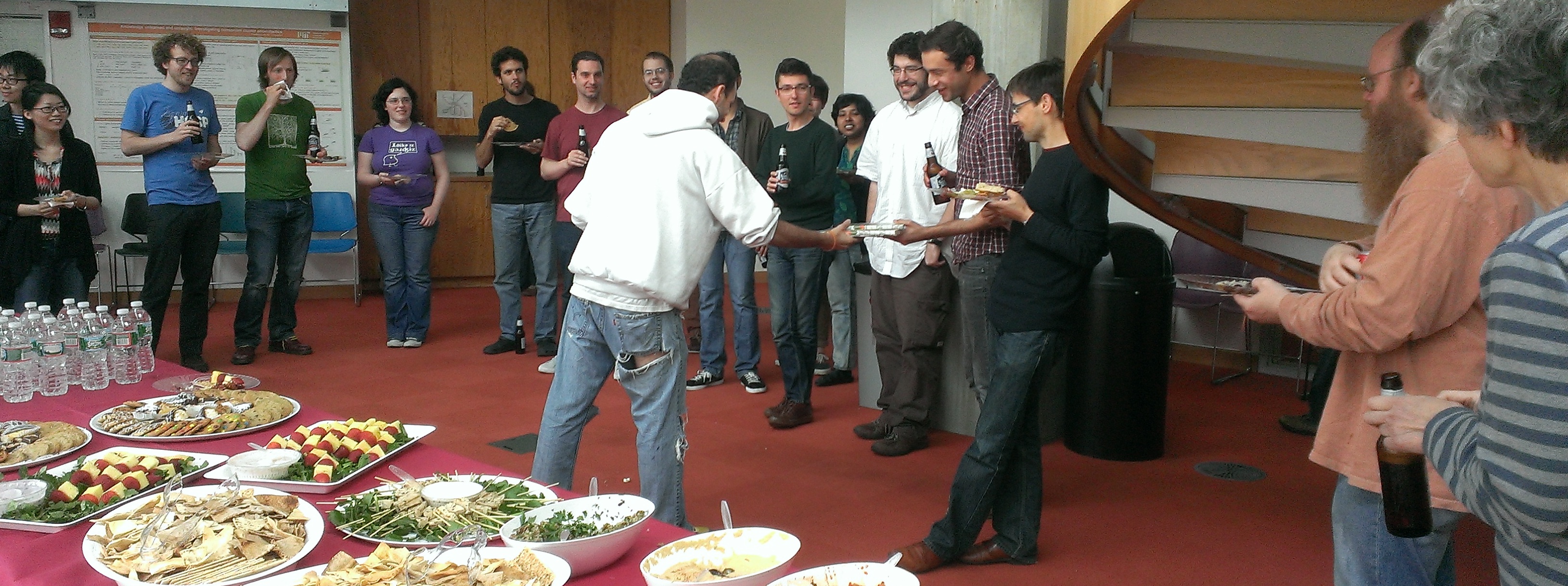
Last Wednesday, the department said our enthusiastic but tearful good-bye to Maziar Toosarvandani, who has been an active, much appreciated member of the department for the past two years as an American Council of Learned Societies New Faculty Fellow — and is now taking up an Assistant Professor position at UC Santa Cruz (as reported here). The grad students presented Maziar with two books about MIT and the Stata Center to remember us by, sentimental speeches were made, N. Paiute nominals and the Persian ezafe construction were discussed, and lots of great food was consumed!
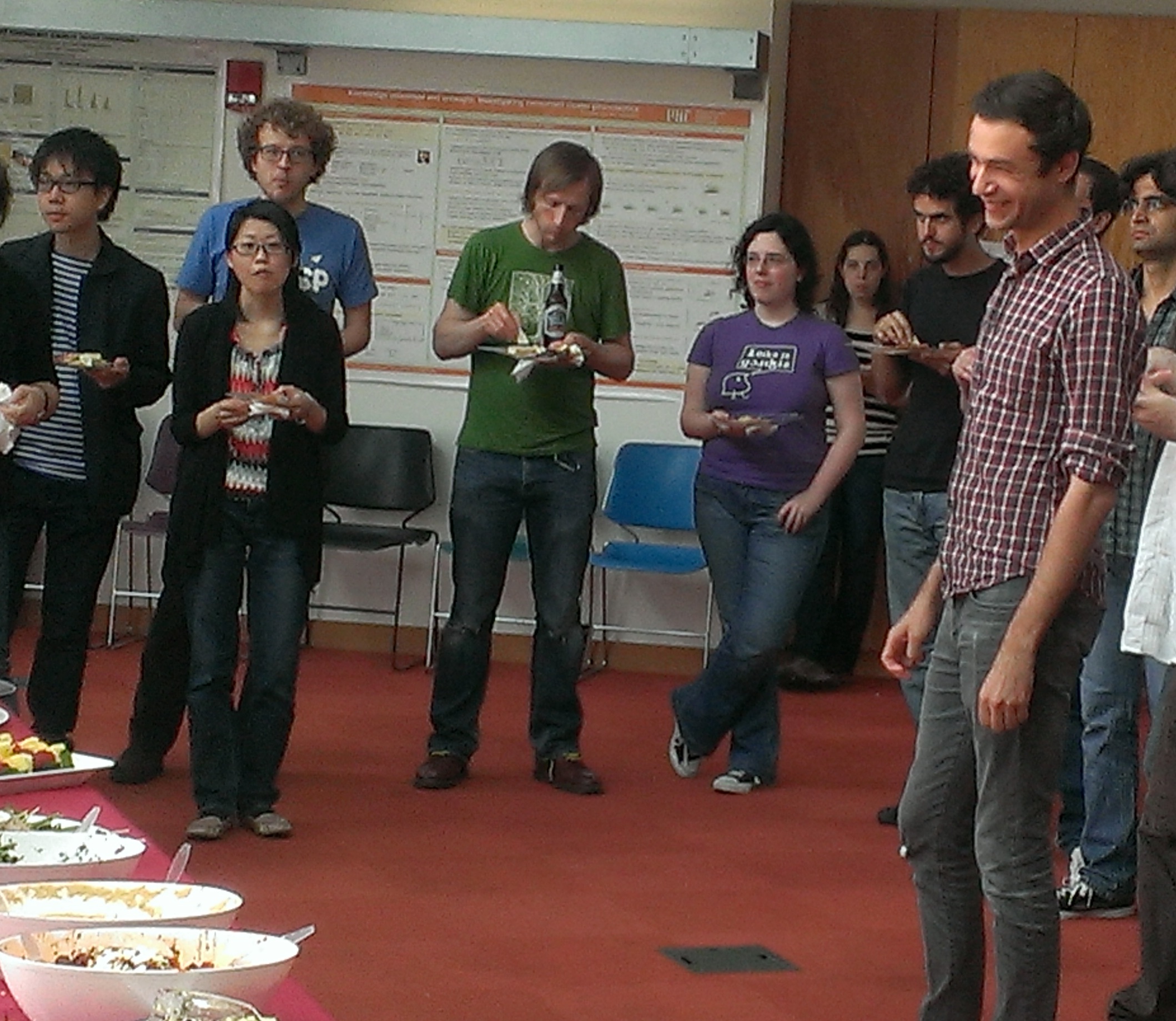
photo credit: Snejana Iovtcheva
Syntax Square 5/7 - Neil Myler
Speaker: Neil Myler (NYU)
Title: Building and interpreting possession sentences in Cochabamba Quecha
Date/Time: Tuesday, May 7, 1-2pm
Location: 32-D461
The full abstract is available here (pdf).
This talk develops an analysis of the syntax and semantics of three different predicative possession constructions in Cochabamba Quechua, a Quechuan language of Bolivia, and draws out the consequences of that analysis for the theory of thematic roles and their place in the grammar.
Ling-Lunch 5/9 - Neil Myler
Speaker: Neil Myler (NYU)
Title: Building and interpreting HAVE sentences in (mostly) English
Date/Time: Thursday, May 9, 12:30-1:45p
Location: 32-D461
The full abstract is available here (pdf).
The literature on the syntax and semantics of possession sentences is vast. However, much of it can be seen as trying to deal with two major puzzles: what we might call the too many meanings puzzle (why do possession constructions across languages have the ability to convey a myriad of seemingly unrelated meanings, like kinship, body parts, permanent ownership, abstract attributes, etc.?), and the too many (surface) structures puzzle (why do possession constructions vary so much in their surface syntax across languages, from transitive HAVE constructions, to existential BE constructions containing an oblique possessor, to copular BE constructions containing a PP possessee?; Why is the transitive HAVE pattern relatively rare?).
I suggest that a solution to both of these puzzles is forthcoming if we take thematic roles out of the syntax, and instead have them be read off from the output of syntax in the semantic component (a conclusion argued for already on different grounds by Schäfer 2008; Wood 2012; Bruening 2013; Marantz 2009, 2013). The post-syntactic conception of thematic roles has an important consequence: whether a given argument-introducing head takes a complement or specifier is determined in the syntax, but whether it assigns a thematic role or not is determined in the semantics. This means that the notion of “syntactic argument of head X” is potentially independent of the notion of “semantic argument of head X”. I argue that this independence is key to understanding the syntactic structures of possession sentences and how they give rise to the gamut of apparently unrelated “possessive” interpretations. In particular, I argue for the following hypotheses, which rely on this conception:
- HAVE and BE are realizations of the same abstract light verb ‘v’. Semantically, this ‘v’ is a type-neutral identity function, which will simply pass the denotation of its complement up the tree (this follows a long tradition of proposals that BE and HAVE are meaningless in themselves).
- This ‘v’ is spelled out as HAVE only if it occurs in the environment of Kratzer’s (1996) Voice, and Voice takes a specifier. Otherwise, this ‘v’ is spelled out as BE. (i.e., HAVE is simply the transitive form of BE- much in the spirit of Hoekstra 1994. The analysis also follows the tradition of Freeze 1992 and Kayne 1993 in taking HAVE to be BE+”something else”, but takes the “something else” to be something other than an incorporated preposition).
- The thematic roles associated with permanent ownership and the various inalienable possession relations (the part-of relation, kinship, etc) are associated with distinct DP-internal argument-introducing heads, but languages may vary in whether they first-merge the possessor in a possession sentence into the specifier of one of these DP-internal positions, or somewhere higher up in the tree.
- The main source of cross-linguistic variation in the syntax of possession sentences is thus the position in which the possessor is introduced into the structure. If the possessor is introduced in spec-VoiceP, we have a HAVE construction/language. If the possessor is introduced anywhere lower than spec-VoiceP (e.g. in a spec position inside the possessee DP itself, in the spec of a pP which takes the possessee as its complement, in the spec of an applicative head, etc.), then we have a BE construction/language.
ESSL 5/9
What: Even more Turkshop results
When: Thursday, May 9, 5:30
Where: 32-D831
Who: Despina Oikonomou, Ruth Brillman, Wataru Uegaki, Paul Marty
This week’s lab meeting will be dedicated to results of projects created by Turkshop participants. We will hear from Despina Oikonomou, Ruth Brillman, Wataru Uegaki and Paul Marty.
Colloquium 5/10 - Andrew Nevins
Speaker: Andrew Nevins (University College London)
Date/Time: Friday May 10th, 3:30-5pm
Venue: 32-141
Title: Agree-Link, Derivational Sandwiching, and Agree-Copy
Abstract:
Recent work on agreement with coordinated DPs has largely converged on the hypothesis that agreement is established in two steps (a move anticipated in Pesetsky & Torrego 2004). Adopting the terminology in Arregi and Nevins 2012, we can refer to these as Agree-Link, or the syntactic establishment of an Agree relation between Probe and one or more Goals, and Agree-Copy, or the postsyntactic (PF) copying from Agree-Linked Goal(s) onto the Probe. Evidence for this split of Agree into two separate steps comes from the fact that they can be derivationally intercalated by postsyntactic operations such as Linearization in Hindi and Slovenian (Bhatt and Walkow, to appear; Marusic, Nevins and Badecker, to appear) postsyntactic morpheme displacement in Bulgarian (Arregi and Nevins, to appear), and Vocabulary Insertion in West Germanic (van Koppen 2005).
Further evidence for this two-step analysis of agreement comes from a different empirical domain, namely, variation in the interaction of agreement with case syncretisms due to postsyntactic impoverishment in Basque dialects and Indo-Aryan languages. In both cases, variation in the realization of agreement is due to a uniform establishment of syntactic Agree-Link relations, coupled with dialect- or language-particular differences in the application of Agree-Copy and its derivational interaction with postsyntactic impoverishment rules. The variation found is thus largely reduced to familiar feeding and counterfeeding interactions among operations in a derivational theory.
The interaction of agreement and case syncretism in these languages thus converges with crosslinguistic coordination patterns in providing evidence for a strongly derivational theory of Agree in which the latter is established in two steps: hierarchically defined syntactic Agree-Link, followed by postsyntactic Agree-Copy, which can interact in different derivationally defined ways with other postsyntactic operations. As such, it provides converging evidence for the view that minimalist and Distributed Morphology approaches to inflection involve sequenced derivational ordering of specific elementary operations (Müller 2008, Epstein & Seely 2002).
